Archived Fire Damage Blog Posts
How to Safely Use a Space Heater?
2/3/2025 (Permalink)
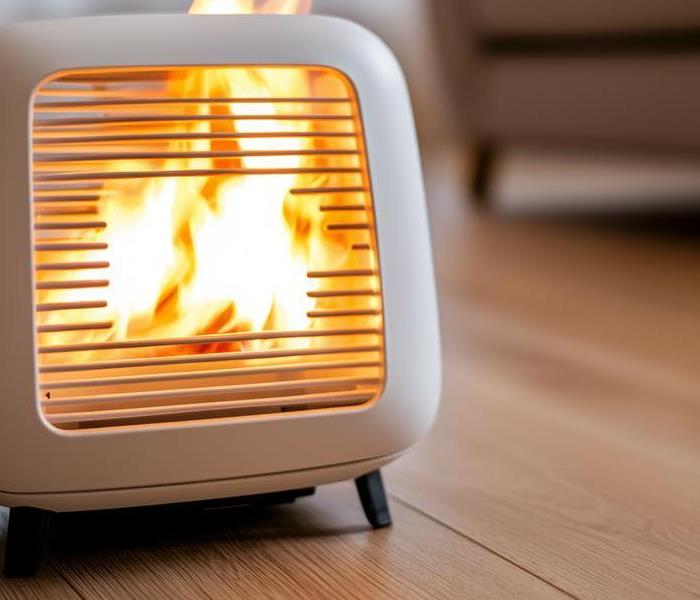 Tips to avoid the chill and avoid a space fire heater!
Tips to avoid the chill and avoid a space fire heater!
Fires can break out at any time in Pearland, and when they occur, our Friendswood/Pearland Central team is Here to Help.® Space heaters are a convenient way to stay warm during colder months, but they can become a serious fire hazard if not used properly. Taking a few precautionary steps can help prevent residential fire damage and keep your home safe.
First, always place your space heater on a flat, stable surface and keep it at least three feet away from flammable materials, such as curtains, bedding, furniture, or papers. Never use a space heater near water or damp areas like bathrooms, as this increases the risk of electrical hazards.
Ensure your space heater has modern safety features, such as automatic shut-off if it tips over or overheats. Avoid using extension cords or power strips to plug in your space heater, which can overload the circuit and cause a fire. Instead, plug it directly into a wall outlet.
Finally, always leave a space heater in the right place and turn it off when leaving the room or going to sleep. Following these safety tips will help reduce the fire risk and keep your home warm and safe during the cold season.
Call Us Today!
When your Pearland home or commercial business has fire damage, SERVPRO Team Zubricki will restore the damage “Like it never even happened.” Call us today.
SERVPRO® franchises are independently owned and operated.
Who to Call For Fire Damage in the Friendswood-Pearland Area?
11/21/2024 (Permalink)
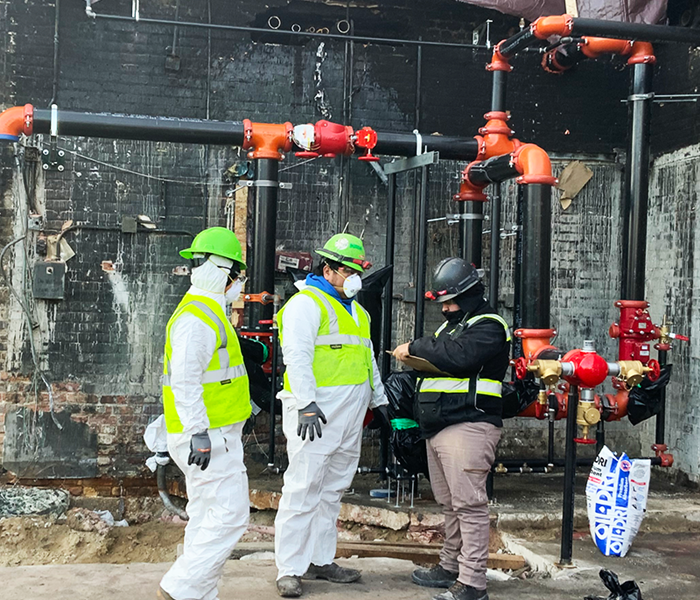 Our professional Friendswood, Pearland fire damage restoration team on-site at a large loss commercial fire.
Our professional Friendswood, Pearland fire damage restoration team on-site at a large loss commercial fire.
When a fire disaster strikes your home or business, it can be devastating, but the fire damage restoration process does not have to be. Here in the Friendswood and Pearland area, destruction from fires to homes and businesses caused by the heat and dry conditions is prevalent. SERVPRO of Friendswood/Pearland Central is able to repair the damage, clean the soot residue and remove the smoke odors.
Friendswood-Pearland Expert Home and Commercial Fire Damage Repair and Clean Up
When it comes to fire damage restoration services, the expert crew at SERVPRO® have been professionally trained, and have vast experience cleaning and repairing fire damage. From kitchen fires to large-loss commercial fires in manufacturing facilities, our team has the experience to complete your full-service fire damage restoration project.
Your dedicated project manager will adhere to a meticulous process per the IICRC Guidelines to ensure the proper protocols are followed.
Why Use a Professional To Clean Up After A Fire?
There are many companies out there that advertise their ability to restore areas affected by fire, but only those with proper training and certification should be considered. The Institute of Inspection Cleaning and Restoration Certification (IICRC) is the main oversight agency in this industry. The IICRC requires its registrants to take extensive coursework before earning their certification. This is a symbol of excellence, and those that uphold the standards that have been set can be contacted through the IICRC. If a professional isn’t hired to clean smoke and fire damage, the probability is high that costs for fire restoration will skyrocket after a few weeks.
A trained, certified, professional company will identify all affected materials and the source of any odors. The only way to properly clean smoke and fire damage is to be extremely thorough. Ash residue is easily disturbed and can spread through a building with ease, causing nearly everything to need restoration. Our experts will identify what can and cannot be salvaged, and will remove any built-up ash residue that is coating surfaces. Over time, ash builds up in layers, and may eventually form into a lacquer-like consistency. Once the fire cleanup is complete, our expert fire restorers will locate the source of the odor, and treat it with specialized detergents that are formulated for neutralizing this kind of odor. Once materials are treated, they may be sealed off to prevent any further odor from permeating the air in the future.
This entire process is very detailed, and hiring a professional like SERVPRO of Friendswood / Pearland Central that can be trusted to do the job right is the best choice.
How is Fire Damage to a Home Repaired?
7/29/2022 (Permalink)
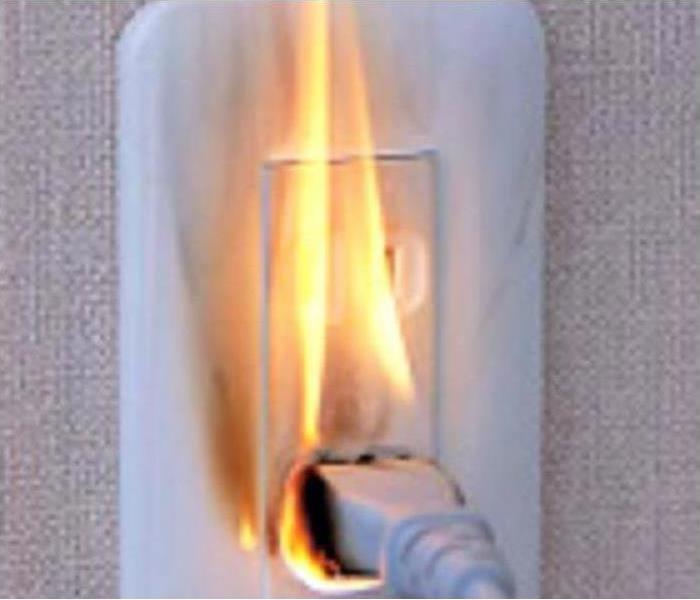 Have Questions? Call Us Today – (281) 412-6211
Have Questions? Call Us Today – (281) 412-6211
There are five different services involved when a home or business is damaged by fire. Our technicians are specially trained to handle this complex process that aims to get you back in your property as soon as possible.
- Mitigation – We’ll secure your property to prevent further damage. Any openings to the home will be boarded up, bulk debris removed, and corrosion mitigation begun in order to increase the likelihood of restoration of sensitive surfaces. If water damage from firefighting efforts has occurred, we’ll work to remove water and begin the drying process.
- Structural Cleaning and Damaged Material Removal – Non-salvageable surfaces and materials will be carefully removed and disposed. Smoke residues will be removed from salvageable walls, ceilings, and structural components of the property.
- Contents Cleaning – Your personal property will receive expert focus, with cleaning taking place right there or off-site, depending on the situation.
- Specialty Restoration Services – If there is anything that requires special attention (electronics, art, furniture refinishing), we’ll ensure a specialist is tasked to complete the work.
- Reconstruction – Sometimes, we have to build back areas that were too damaged to restore.
Have Questions? Call Us Today –
Friendswood/Pearland, Stafford, Missouri City North and Fresno
Fire Damage Restoration including Smoke and Soot Cleanup Friendswood, TX (SERVPROfriendswoodpearland.com)
What are the Best Ways to Eliminate Smoke in Your Home?
2/1/2022 (Permalink)
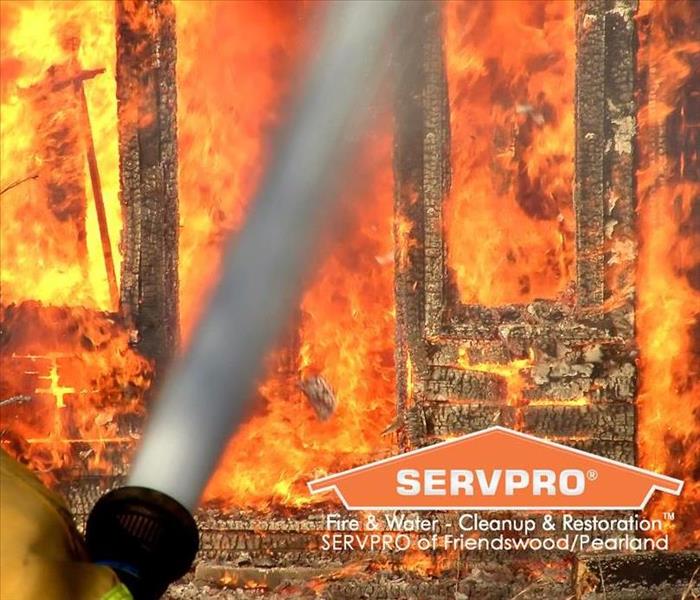 Have Questions? Call Us Today – (281) 412-6211
Have Questions? Call Us Today – (281) 412-6211
Removing Smoke Odors from Your Home After Fire Damage Requires Expertise
Fires are one of the worst accidents that can occur in a home. They not only ruin household items and structural materials irreversibly and quickly but also result in several additional hazards. Examples include water damage resulting from fire-extinguishing efforts, unpleasant odors, and soot damage.
It can take hours of cleaning to restore your home. You need to deal with the repulsive smoke odor that lingers after a fire accident. Eliminating the smoke odor is daunting because the smoke particles embed in different porous materials like clothing, draperies, upholstered furniture, and carpeting. Some steps to you can take to deal with the smoke scents include:
Remove all items affected by the smoke scent
You can wash things like drapes, carpets, clothes, and bed covers to remove the smoke smell. Before you clean them, take them out or at least separate them from other items.
Air out your home
Open the windows and place fans in your home for a few hours. The ventilation process helps blow away most smoke particles lingering inside your home. You can set the fans near open spaces, so they draw in the fresh air more efficiently.
Removing stubborn smoke odors requires effort and specialized equipment. It is not always possible to identify what is causing the smell or which deodorization method can counteract a particular source of the scent. Therefore, we often use multiple procedures that involve different professional products and equipment to remove unpleasant odors.
Our technicians can use deodorant granules or pellets to eliminate the scents. These products work by absorbing odors. Their main active ingredient is a material referred to as fuller’s earth, and it acts as a sponge to absorb and hold the smells. We can apply them to a specific area or the whole house. Some equipment we can use to remove smoke odors include:
- Low Volume (ULV) misters
- Hydroxyl generators
- Air scrubbers
- Photocatalytic oxidizers
- Injection Devices
Our SERVPRO Technicians can also ensure effective restoration of your home by eliminating the troubling reminders of smoke, soot and odor damage from at-risk items like tile, chrome, aluminum, brass, porcelain, upholstery, fabrics and carpets.
If your home has lingering smoke odors after a fire, give SERVPRO of Friendswood/Pearland, Stafford, Missouri City North and Fresno a call at (281) 412-6211 for more information. Our team is professionally trained and can help you neutralize the odor to make it “Like it never even happened.”
The Basics of Smoke Odor Remediation
1/27/2022 (Permalink)
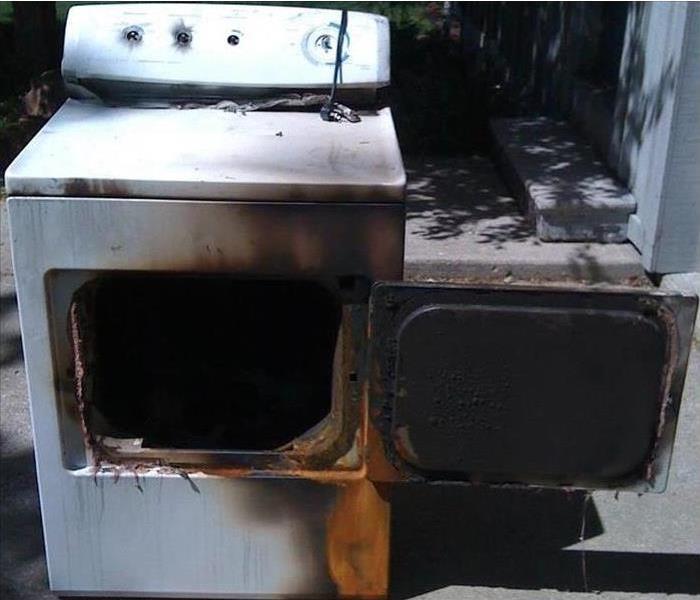 Choose SERVPRO, a local company that specializes in fire, water and storm damage restoration.
Choose SERVPRO, a local company that specializes in fire, water and storm damage restoration.
House fires often cause a significant amount of residual smoke odor. While smoke cleaning products advertise odor removal, most fires will require the expertise of a remediation company. Odor remediation typically comprises a four-step process.
- Remove damaged items
- Clean
- Run equipment
- Seal materials
4 Steps For Smoke Odor Remediation
1. Remove Damaged Items
To get an actual idea of the level of odor in your home, a remediation crew will want to remove any visible smoke damage, including damaged items that may hold odor. The salvageable items removed from your house will undergo cleaning separate from the property. You can find several local cleaners who specialize in smoke-damaged materials.
2. Clean
With all loose items and debris out of your home, the remediation crew will begin the smoke cleaning process. The physical cleaning may involve disinfectants, detergents, and other materials to scrub and remove the remaining soot. However, the company may spend a significant amount of time vacuuming the space to ensure they do not make matters worse.
3. Run Equipment
The mitigation crew may use a variety of equipment to help reduce the odors in the air. For example, air filtration devices, thermal foggers, and ozone machines are standard tools used in odor removal. The team may also need to use shop vacs, water pumps, and dehumidifiers to remove excess water and dry the house from fire hose exposure.
4. Seal Materials
Many remediation companies may suggest sealing porous materials, like wood floors, to trap the odor rather than replacing the material. While replacement is the best way to remove odor, it is not the most cost-effective solution, especially when the structure and appearance of the material remain intact.
Many homeowners try DIY smoke cleaning to save a few bucks, but when dealing with the aftermath of a significant fire, DIY methods are not the most workable solutions.
We are Here to Help® and ready to respond to fire, wind and soot conditions in Houston and all surrounding areas.
Have Questions? Call Us Today – (281) 412-6211
Electrical Fire in Your Home?
1/24/2022 (Permalink)
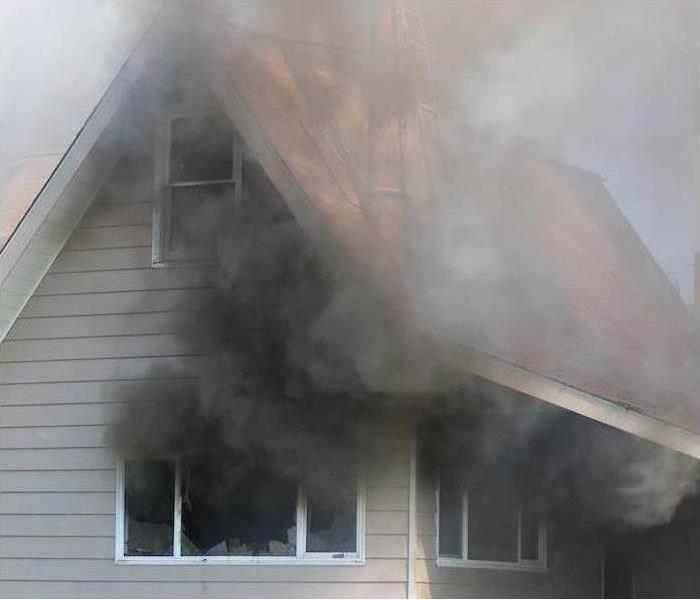 We restore fire damage.
We restore fire damage.
SERVPRO® of Friendswood/Pearland, Stafford, Missouri City North and Fresno has been restoring fire damage for homeowners and businesses for over twenty years. Here are some electrical safety tips from the National Fire Protection Association:
- Have all electrical work done by a qualified electrician
- Only use one heat-producing appliance plugged into a receptacle outlet at a time
- Major appliances should be plugged directly into a wall receptacle outlet. Extension cords and plug strips should not be used.
- Arc-fault circuit interrupters (AFCIs) shut off electricity when a dangerous condition occurs. Consider having them installed in your home.
- Use ground-fault circuit interrupters (GFCIs) to reduce the risk of shock. GFCIs shut off an electrical circuit when it becomes a shock hazard. They should be installed inside the home in bathrooms, kitchens, garages, and basements. All outdoor receptacles should be GFCI protected.
- Test AFCIs and GFCIs once a month according to the manufacturer’s recommendations.
- Check electrical cords to make sure they are not running across doorways or under carpets. Extension cords are intended for temporary use. Have a qualified electrician add more receptacle outlets, so you don’t have to use extension cords.
Call Us!
When you need fire restoration services for your home or business, SERVPRO® of Friendswood/Pearland, Stafford, Missouri City North and Fresno is Here to Help. ®Call us at (281) 412-6211. We’ll clean and restore your fire damage, “Like it never even happened.”
Franchises are Independently Owned and Operated.
After the fire...
12/29/2021 (Permalink)
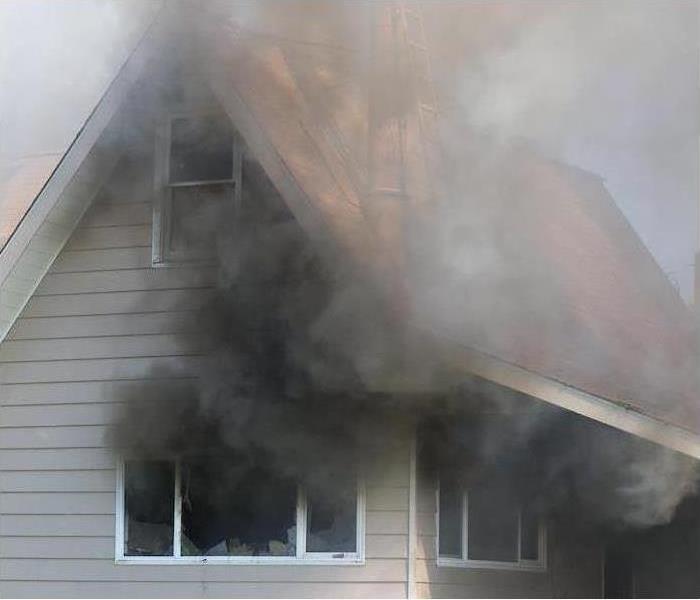 You may feel stressed and confused after such a disaster, and you’ll need a caring expert to guide you through this crisis.
You may feel stressed and confused after such a disaster, and you’ll need a caring expert to guide you through this crisis.
There are several problems that a fire in your home or business leaves behind even after the immediate danger has passed. It is often the case that a thorough cleaning of walls, ceilings, carpeting, woodwork, and flooring will need to be professionally done. There are also several steps that can be taken in order to prevent further damage until SERVPRO of Friendswood/Pearland, Stafford, Missouri City North and Fresno arrives on the scene. The chances of an effective restoration will be boosted by reducing damage by following a few tips:
- Try to keep movement in the home to a minimum. Soot can become ingrained in the upholstery or carpeting from repeated movement in the home.
- Use old towels or linens to cover up high traffic carpeted areas and upholstery.
- If the power is off, empty the refrigerator and freezer of all contents and prop open the door to help prevent unpleasant smells.
- Be mindful of what you are touching. Your hands can become soiled with soot and that can be transferred to other items in the home.
- If you can immediately wipe all the soot off sink faucets and metal window molding, then coat with petroleum jelly to prevent the soot from pitting the metal surfaces.
Following just a few of these steps can be a game changer in the restorability of your home and personal items. SERVPRO of Friendswood/Pearland, Stafford, Missouri City North and Fresno is here to help you through a catastrophe that is a fire loss. If you suffer a fire or smoke damage, remember we are your fire restoration experts backed by years of experience and a team of knowledgeable individuals.
Sound the Alarms
12/10/2021 (Permalink)
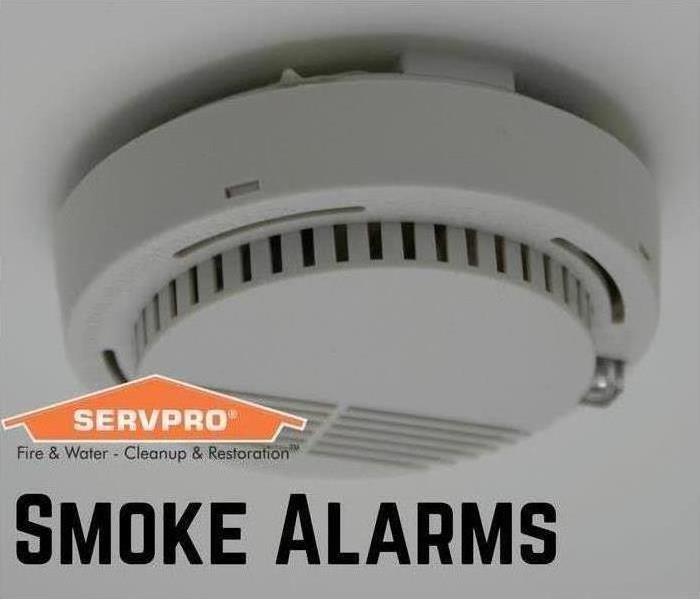 Practicing the prevention of fires, and keeping batteries in your alarm is important, however, if you do experience a loss contact SERVPRO.
Practicing the prevention of fires, and keeping batteries in your alarm is important, however, if you do experience a loss contact SERVPRO.
Have you tested your fire alarms lately? According to the Red Cross, you could have as few as only TWO MINUTES to escape safely from your house after a fire begins.
This is why testing your fire alarms should be a part of your home maintenance routine! These alarms in your home make sure that you get alerted as soon as possible that a fire has started.
The next item on the list is having a planned fire escape route. BUT, having it isn't enough- you need to have practiced this route with your family ahead of time. Check out this free worksheet from the Red Cross to help you as you plan for your home!
Two minutes is quick, but disaster strikes in the blink of an eye. Make sure that your family and your home are ready. Once your family is safe, you can call in the professionals to handle your home.
SERVPRO of Friendswood/Pearland, Stafford, Missouri City North and Fresno is locally owned and operated, so we’re already close by and ready to respond immediately when you need us. We make disaster "Like it never even happened." Give us a call today!
Office (281) 412-6211
Kimberly Robb (281) 520-8197
Madeline Beeler (281) 520-8196
Pack-Outs for Soot-Damaged Items
7/14/2021 (Permalink)
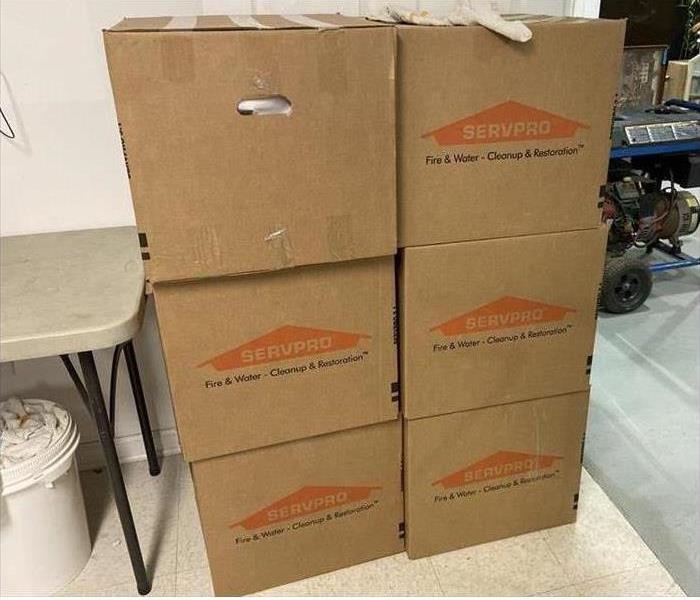 Pack-out boxes with contents ready to be cleaned at our local warehouse.
Pack-out boxes with contents ready to be cleaned at our local warehouse.
After dealing with clean up and recovery from a fire in a business or home, the last thing one wants to handle is cleaning every soot-damaged item in the building. One of our many services for fire damage and restoration is our Pack Out service.
This can involve carefully
- Packing soot-damaged items
- Transporting them to our warehouse for storage and cleaning
- Attentive restoration using high-tech methods, such as our Ultrasonic machine.
- Wrapping restored items in paper or bubble wrap
- Re-boxing them for delivery to the owner….Voila’!!
Our ultimate goal is to restore items to pre loss condition. However, not everything is able to be fully restored after being damaged by fire. In which case replacement is recommended.
For information about our fire-damage restoration process click here
SERVPRO of Friendswood/Pearland, Stafford, Missouri City North and Fresno is locally owned and operated and is a “trusted leader in the restoration industry”. We are available for Emergency Service 24/7.
Call Kimberly Robb at 281-520-8197.
Office 281-412-6211.
The Importance of Professional Smoke Removal After a Fire
1/25/2021 (Permalink)
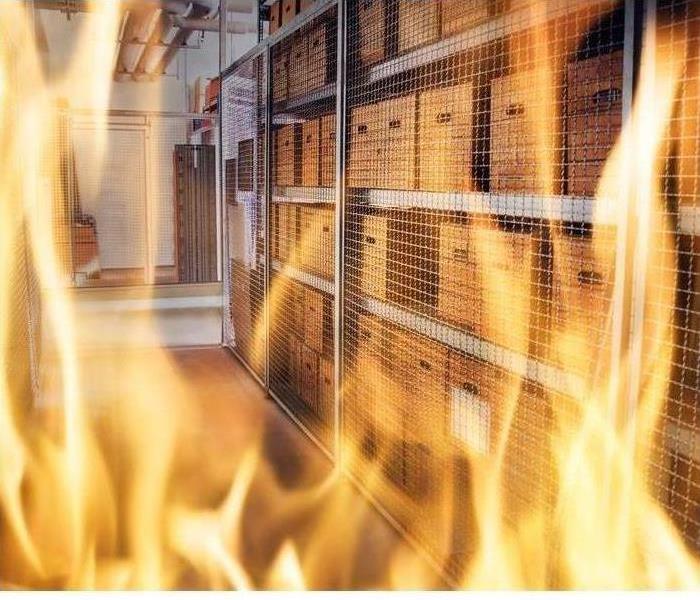 Removing Smoke, Odor, and Soot After a Fire.
Removing Smoke, Odor, and Soot After a Fire.
It may come as a surprise to many that the biggest cause of death and illnesses resulting from a fire is not the fire itself but smoke. Homes and commercial spaces are filled with many different materials, both in the structure and home furnishings. Not all materials burn clean, often releasing hazardous toxins. Some of these chemicals can break into particulate matter: extremely small solid or liquid particles. These particles are easily inhaled or absorbed via skin contact, potentially causing health effects. While most every fire has particular matter and carbon monoxide, there are other chemicals to know and be weary of.
Burning barrels of trash is not encouraged with highly regarded warnings because of the dyes, pigments, coatings, and other components of everyday trash. Allowing these chemicals to be released into the air and environment around you is extremely harmful. This holds true to the burning of non-trash household items as well. For instance, treated wood that is burned can release arsenic, copper, or creosote. The chemicals found in treated wood are used to preserve the wood from everyday wear; they are not meant to be burned, therefore considered as possible carcinogens. Another commonly found material is plastic. Burned plastic can release hydrochloric acid, sulfur dioxide, and other heavy metals. Inhaling any of these compounds can potentially cause damage to the immune and respiratory system.
SERVPRO of Friendswood/Pearland, Stafford, Missouri City North and Fresno has dealt with many residential and commercial fires, providing cleaning and restoration in a safe, professional manner. Our technicians have the proper equipment and safety gear to avoid the effects of lingering toxins.
If your home is in need of soot, smoke, or odor removal, call the professionals at SERVPRO, (281) 412-6211.
Let US Assist YOU with the Fire Damage Cleanup Process
1/14/2021 (Permalink)
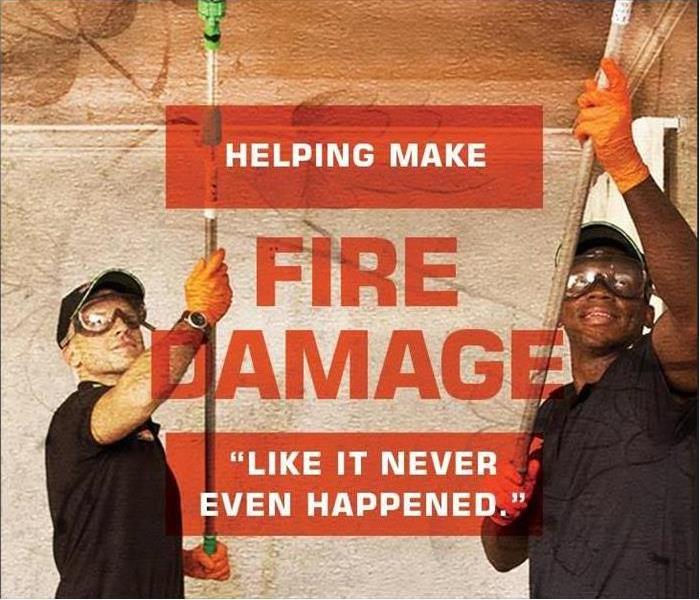 After the fire department leaves, Call SERVPRO to evaluate the damage!
After the fire department leaves, Call SERVPRO to evaluate the damage!
Let SERVPRO Assess and Evaluate Your Fire Damaged Household Items
Most homeowners are eager to get into their homes again after a fire event, which is perfectly understandable. However, many people are not aware that once they call a restoration professional, there are key actions they can take to help the process along.
After you've called SERVPRO to handle your home's fire damage, there are several important things that you can do to make cleanup and restoration go more smoothly. Here's how we can work together to quickly get your home back in great condition.
Gather pertinent information about your home insurance policy.
We have years of experience mitigating insurance claims and working with homeowners to ensure that their claims are approved. If you keep your policy details and contact information for the company handy, we will be able to work with the adjuster more quickly.
Be careful not to throw away any items.
One of the primary benefits of working with the professionals at SERVPRO is that we have the ability to restore and clean a wide variety of items affected by fire damage. This does not just include surfaces and fixtures in your home, but furnishings, appliances, rugs, window treatments, and even documents. Rather than automatically tossing things and deeming them to be a total loss, let us evaluate it first. We will also take care of properly disposing of any debris and unsalvageable items in a way that minimizes the risk of health hazards.
Stay safe -- we will handle the tough jobs.
It may seem like a helpful thing to go back to your home and try to physically assist with cleanup and repairs, but our first concern is the safety of your family. There are some lingering hazards that go along with fire damage, and until we have determined that your home is safe to occupy again, it is important to be careful when you are on-site.
The team at SERVPRO of Friendswood/Pearland, Stafford, Missouri City North and Fresno is ready to help get your home back in order so you can start enjoying it again and have peace of mind. For more information about our fire damage restoration services or to obtain a quote, call us 24/7 at (281) 412-6211.
Fire Pit Safety
1/13/2021 (Permalink)
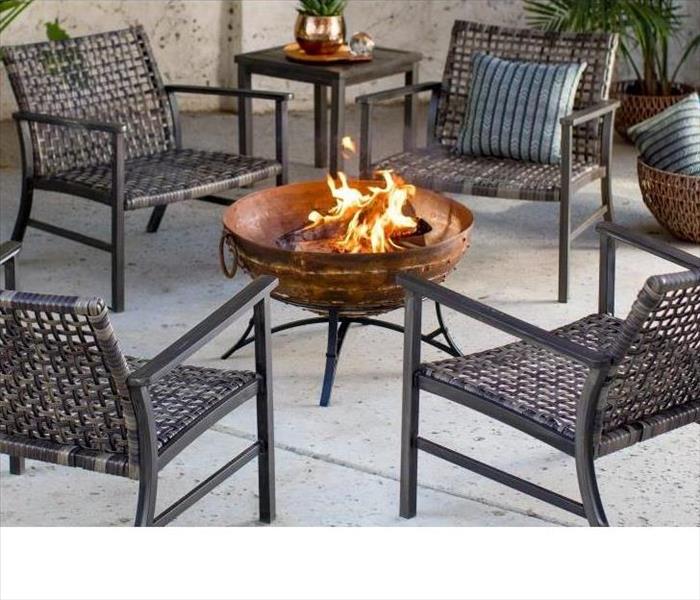 Commercial or Residential Fire?
Call us at 281-412-6211. Faster to any size disaster.
Commercial or Residential Fire?
Call us at 281-412-6211. Faster to any size disaster.
For many families it's a tradition to enjoy the nights outside around a homemade fire pit! Many of us are looking forward to spending time gathering around them to enjoy time with family and friends. Before you start dreaming of moonlit nights and toasted marshmallows, take a moment to check out some of these tips to remember.
Backyard Fire Pit Safety Tips:
- Whether you prefer a built-in or portable fire pit, choose one that is not too large for the area. The pit should be a minimum of 10 feet away from any structures or combustible materials as well as away from trees, fences, sheds, power lines, and telephone wires, 25 feet away from apartment or multi residence buildings.
- Make sure that the seating area is large enough and properly placed for comfort and ventilation.
- Check wind direction before lighting a fire.
- Don’t use flammable fluids (gasoline, lighter fluid, etc.) to light or relight fires.
- To start the fire, use a lighter to ignite crumpled pieces of paper covered with small sticks. Then, add larger sticks and a log or two to keep it burning.
- Burn only dry material. Damp material will create excess smoke.
- Use a commercial fire pit screen on top to help prevent large amber from leaving the controlled area.
- Don’t wear flammable clothing (like nylon) or any loose-fitting clothing.
- Never leave the fire unattended and keep pets and children far away from the fire as they will be attracted to it.
- Keep a fire extinguisher, garden hose, or bucket of water nearby.
- As the fire dies down, use a shovel and spread out the ashes to allow them to cool down. Then slowly pour water over those ashes and watch them closely to be sure that no burning embers remain or reignite. Put the cooled ashes in a specially designated ash storage metal can.
How Do You Clean Your Belongings After a Fire?
12/28/2020 (Permalink)
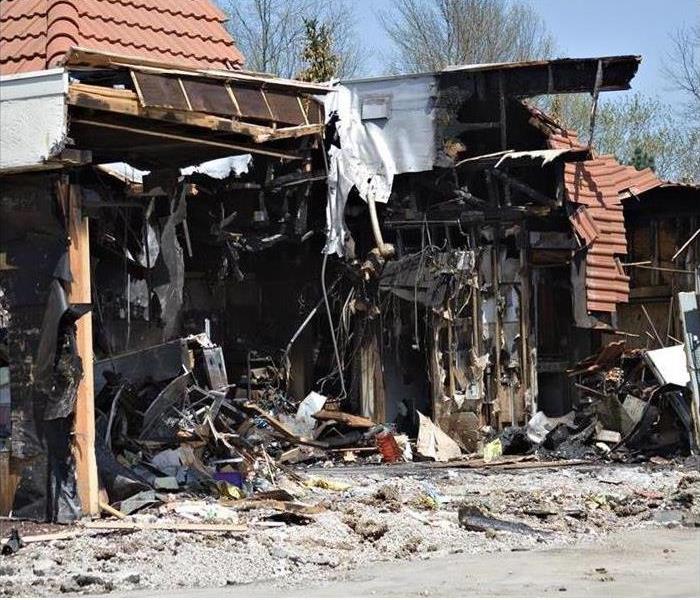 Cleaning your home after a fire takes a lot of time and work, but it can be done. Get help from SERVPRO.
Cleaning your home after a fire takes a lot of time and work, but it can be done. Get help from SERVPRO.
The fire trucks have left and the Fire Marshall says your home is safe again, but a strong, smoky odor remains. Will you have to get rid of everything? How much dry-cleaning, wall-scrubbing and airing out is it going to take to get your life back to normal? Here are some content cleaning guidelines to help you get started.
Clothing
Dry-cleaning is often the best choice for getting smoke-damaged clothing clean, but there are alternatives. Easy-care clothes with a light smoke smell can be washed using your normal laundry detergent and a tablespoon of vanilla. Stronger smells and soot may need to be washed by a textile professional who specializes in smoke and soot removal.
Upholstery and Carpet
Removing odors and soot from upholstery and carpet may require a dry-cleaning step followed by a wet-cleaning step. Talk to a professional, to determine what process will work best for your situation.
Non-Porous Items
Items made of metal, glass, rubber, plastic and ceramic can be cleaned effectively using ultrasonic machines. These machines use high frequency sound waves to remove smoke particles from your possessions.
Walls and Ceilings
If your walls and ceilings are blackened from the fire, you may want to consider using temporary content storage for your moveable possessions so that you can focus on cleaning the structure itself. As with carpet and upholstery, it may take several steps to get things satisfactorily clean. These steps may include scrubbing with detergent, scrubbing with trisodium phosphate and, sometimes, applying fresh primer and paint.
Cleaning your home after a fire takes a lot of time and work, but it can be done. Tackle cleaning projects such as dry-cleaning and carpet shampooing one at a time. Get help from friends, family and your restoration professionals at SERVPRO of Friendswood/Pearland, Stafford, Missouri City North and Fresno. And rest assured that your life will indeed return to normal soon.
The Fire Damage Process-What to Expect
12/24/2020 (Permalink)
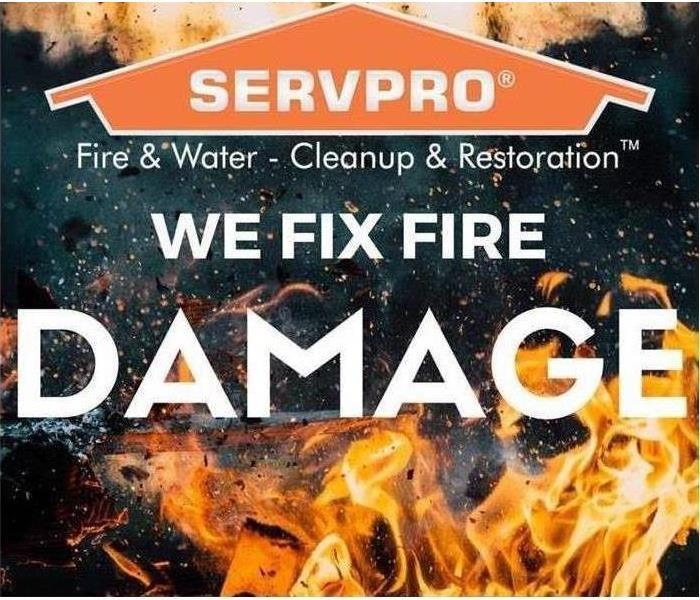 After you call the insurance company, you will immediately need to start the fire damage restoration process.
After you call the insurance company, you will immediately need to start the fire damage restoration process.
Fire damage to your home or a fire in your business can wreak havoc on your life. Once the fire is over, the real trouble beings. There are many things you will have to do to get your life and property back in good order. After you call the insurance company, you will immediately need to start the fire damage restoration process. This means calling in highly-skilled professionals to get your home back in pre-fire condition. Once the fire trucks leave you will have water damage from the hoses, smoke damage, soot damage and areas that need board up.
The same goes with fire in your business. You will need a team to deal with commercial fire damage. The entire process can be minimized once you call in a restoration company to help. The are always available day and night, and even on weekends, holidays and emergency situations. Fires can happen at any time, and you need to get the ball rolling as quickly as possible.
After a fire in the home, the first thing a restoration company will do is a professional assessment of the situation. Your home or business will have a strong smoke smell, soot damage and smoke damage that should be worked on immediately. A plan of action will be quickly formulated.
Immediate tarp and roof board up will begin. The professionals will board up all areas such as windows, doors and even the roof if needed. This will prevent further damage with rain or wind. Tarp will also be applied over the board up if necessary.
After fire damage, water removal is a crucial step. Lingering water can set up mold. Part of the fire damage restoration process will require the scrubbing of walls, furniture, upholstery and even carpeting to rid them and the home of soot damage, smoke smell and any other damage. The entire fire cleanup process will be performed quickly and professionally. A restoration company team consists of many people doing a variety of jobs such as odor control technician, fire and smoke restoration technician, upholstery and fabric cleaning technician and water removal technician.
Fire clean up after commercial fire damage is similar to fire in the home, just on a larger scale. The fire cleanup is performed in a way as not to disrupt your life. The fire damage restoration team will perform the process of sanitation. They will use scrubbers and foggers to eliminate any trace of smoke smell, smoke damage and soot damage.
The last step after a fire in your home is the restoration process. The restoration company can replace anything that received fire damage such as drywall. The fire damage restoration process will ensure that all remnants of fire damage will no longer exist. Fire cleanup after a commercial fire damage has its own set of issues. Odors are one of the biggest things to drive customers away. Teams will take care of the smoke damage and smoke smell that lingers after a fire in your home or business.
Professionals take special care when dealing with fire cleanup after a fire strikes your business. Commercial fire damage can cost you money and time. It is imperative that you get your business up and running as quickly as possible.
Have Questions? Call Us Today – (281) 412-6211
Visit OUR WEBSITE for more information on fire damage.
Smoke Alarm Safety
7/14/2020 (Permalink)
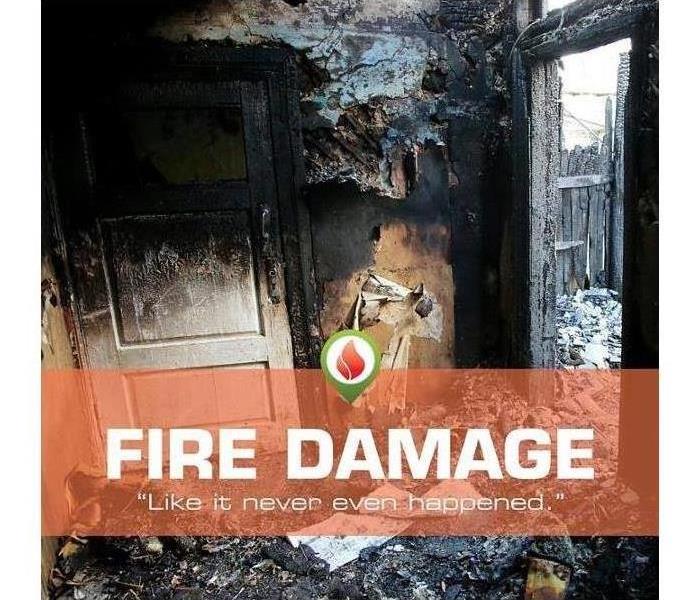 Checking your smoke detector's batteries can help save you or the life of a loved one in the case of a fire.
Checking your smoke detector's batteries can help save you or the life of a loved one in the case of a fire.
You probably know what the smoke alarm in your home looks like. You should also (hopefully) know where it’s located. The big question you should ask yourself is, “Does it work?” The Residential Fire Safety Institute shows that over 92% of dwellings in the US have smoke alarms. Which sounds like a great statistic, right? But it’s also estimate that one third of those smoke alarms do not work.
Smoke alarms are fairly low maintenance, however, they cannot simply be installed and forgotten. Here are some tips to keep your smoke alarm functioning properly:
- Replace smoke alarms every decade. After 10 years, smoke alarms have a 30% failure rate.
- Vacuum alarms once every 6 months to once a year. An alarm clogged with dust and debris can affect the alarms’ ability to function properly.
- Install both ionization and photoelectric alarms. The ionization detectors activate quicker for flare ups or flaming fires, while photoelectric detectors work better for slow, smoldering fires.
- Test your fire alarms once every 3 months.
click herefor more information.
Call 281-412-6211 to schedule a consultation.
How to Deal With the Aftermath of a House Fire
7/6/2020 (Permalink)
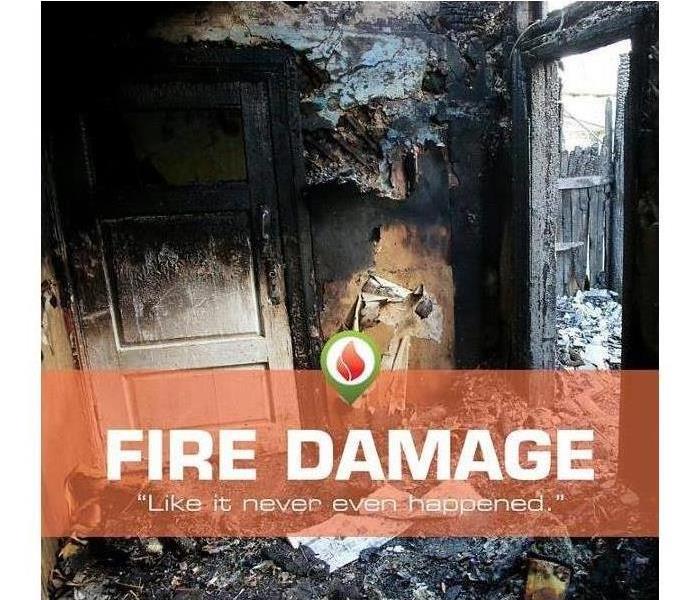 Call SERVPRO of Friendswood/Pearland, Stafford, Missouri City North and Fresno at (281) 412-6211 anytime, day or night, to help you
Call SERVPRO of Friendswood/Pearland, Stafford, Missouri City North and Fresno at (281) 412-6211 anytime, day or night, to help you
A house fire is an absolutely devastating situation. No matter how quickly the fire was extinguished, it can still cause serious household damages and emotional repercussions for your entire family.
While handling the damage may seem overwhelming, you can make sure you are doing everything in your power to recover quickly and lessen the impact on your home and your mental well-being.
Enlist emotional support.
The damage that fires cause can be alarming to see firsthand. Firefighters will often have to break windows or cut holes in the roof or walls, and many items that were not near the fire may still be damaged by smoke, soot and water from the fire extinguishers. When you are preparing to see your home for the first time after a fire, understand that it will be traumatic and you will need to grieve. Bring people who can provide emotional support to you and your family, and be open to seeking therapeutic counseling to help yourselves through the grieving process if needed.
Wait to enter your home.
Though things may appear to not be damaged enough to make your home a hazard, never enter without first checking with officials to determine everything is safe. The invisible damage a fire causes can undermine a home’s structural elements, and a second combustion may even be possible depending on the source of the fire. Make sure you always wait for the official OK before reentering your home.
Contact your insurance company.
As soon as possible after the fire, contact your insurance agent to find out what your homeowners insurance policy covers and start your claim. Because policies vary so wildly, this should be done early on so you do not risk accidentally undermining your claim.
Document the damages.
Do a full inventory of all the damages, and take detailed photographs so you have record of everything in the home that is impacted. Not only will this be helpful as you work with your insurance adjuster, but it is also a handy tool for your personal records so you can see what you will need to replace in the home. It’s wise to have an ongoing inventory of your personal belongings before you experience a fire. If you already have a documented inventory, use that as a guide when assessing damage.
Contact your restoration company.
There is not enough good that can be said about working with a qualified fire restoration company to help you mitigate the damages. Fires are extremely stressful for your entire household, but working with a company you can trust, like SERVPRO of Friendswood/Pearland, Stafford, Missouri City North and Fresno, can alleviate many worries and headaches. We are experts at handling the details after a fire. We can help guide you through difficult steps, save you extra work and answer many of your questions along the way.
Call SERVPRO at (281) 412-6211 anytime, day or night, to help you recover after a fire. We live and work in your local Houston areas and understand what you need most after experiencing this kind of traumatic disaster. We’re ready to help!
Preventing Lint Fires and Damage
1/22/2020 (Permalink)
Dryer fires are more likely to occur during the fall and winter months, with the month of January seeing the most dryer fires. However, it is just as important to practice fire safety by cleaning out your dryer vent as often as necessary.
When should I clean my dryer vent?
- You should clean out the ling filter after every load of laundry.
- Check the back of the dryer for lint buildup every other week.
- Every few months you should clean the exhaust for lint buildup.
If you experience a dryer fire, you should call firefighters to make sure that the blaze is extinguished. You may also want to contact a residential damage restoration services in Pearland,TX to repair damage to the area surrounding your laundry machines after a lint fire.
Smoke and Soot Cleanup
1/22/2020 (Permalink)
Smoke and soot is very invasive and can penetrate various cavities within your home, causing hidden damage and odor. Our smoke damage expertise and experience allows us to inspect and accurately assess the extent of the damage to develop a comprehensive plan of action.
Smoke and soot facts:
Hot smoke migrates to cooler areas and upper levels of a structure.
Smoke flows around plumbing systems, seeping through the holes used by pipes to go from floor to floor.
The type of smoke may greatly affect the restoration process.
Different Types of Smoke
There are two different types of smoke–wet and dry. As a result, there are different types of soot residue after a fire. Before restoration begins, SERVPRO of Friendswood/Pearland will test the soot to determine which type of smoke damage occurred. The cleaning procedures will then be based on the information identified during pretesting. Here is some additional information:
Wet Smoke – Plastic and Rubber
Low heat, smoldering, pungent odor, sticky, smeary. Smoke webs are more difficult to clean.
Dry Smoke – Paper and Wood
Fast burning, high temperatures, heat rises therefore smoke rises.
Protein Fire Residue – Produced by evaporation of material rather than from a fire
Virtually invisible, discolors paints and varnishes, extreme pungent odor.
Our Fire Damage Restoration Services
Since each smoke and fire damage situation is a little different, each one requires a unique solution tailored for the specific conditions. We have the equipment, expertise, and experience to restore your fire and smoke damage. We will also treat your family with empathy and respect and your property with care.
Ash Damage
1/22/2020 (Permalink)
Ash is one of the most destructive factors in a fire, second only to the blaze itself in potential to harm your home. In some cases, ash may be present in such large volumes that it causes thousands of dollars in damage all on its own. Ash is difficult and labor-intensive to remove, but with the right crew and the right strategy, SERVPRO makes short work of it. So, where is ash most liable to cause extensive damage?
When Mixed With Water
In Pearland fire damage cases, ash often combines with water to create a staining and difficult-to-handle sludge. This material may require extra care and slower extraction than other material, costing time and energy otherwise spent on restoring other types of damage including burns and smoke odors. This material, while visually disastrous and time-intensive to take care of, is thankfully relatively straightforward to clean up and remove from a home.
Clogged Drains And Pipes
Ash is highly liable to clog up drains and pipes around the home. While lighter clogs may be easy to clean up and remove, in some cases ash may fill up an entire section of pipe and become packed in. When this happens, the pipes may have to be removed and flushed out with specialty equipment. SERVPRO technicians usually examine each water fixture in your home thoroughly to determine how severe the damage is before ripping out pipes.
Carpeting And Floor Materials
The most likely place for ash to end up is on your floor. Depending on the intensity of the fire, flooring may receive multiple inches of ash cover. This material is staining, dusty, and difficult to remove from most types of carpeting. In some cases, the carpet may have to be removed to allow for cleaning or replacement.
SERVPRO of Friendswood/Pearland has been helping local homeowners to recover from fire damage for years. Give us a call around the clock at (281) 412-6211 for our services
Benefits of Professional Houston Fire Damage Cleanup
12/2/2019 (Permalink)
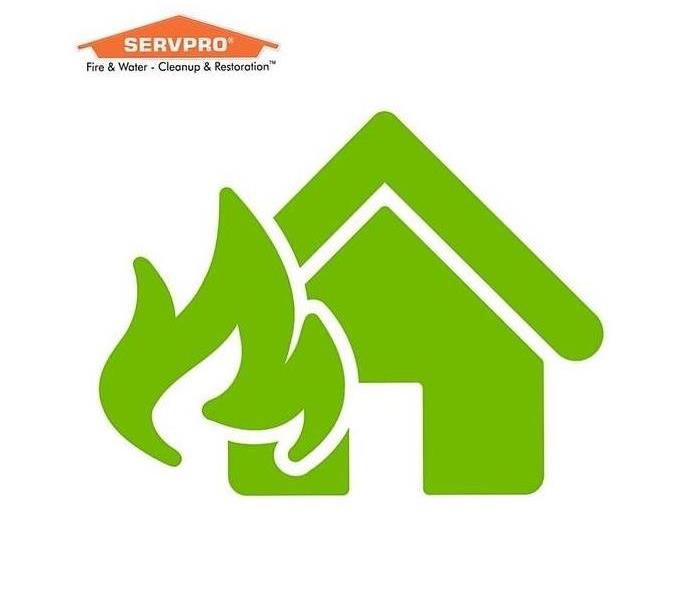 Benefits of Fire Restoration
Benefits of Fire Restoration
The reasons why professional fire cleanup is the crucial focus on safety and thorough remediation in Houston as elsewhere. A seemingly minor fire quickly extinguished, might appear to need merely a slightly more intense than usual seasonal cleaning. Taking this perspective is risky, with the potential to expose your loved ones and the structure of your home to invisible yet severe progressive damage.
Significant Water Damage
Merely because it was introduced on purpose to mitigate fire damage in your home does not negate the hazards of water damage. Slips and falls, electrical shocks, and permanent harm to building materials are just some of the dangers of firefighting water incursion. Efficient water removal and structural drying are essential before or while soot and other debris is cleared. Our technicians hold multiple certifications from the Institute of Inspection, Cleaning and Restoration Certification (IICRC) and can move between tasks seamlessly.
Safety Concerns When Managing Toxic Residues
Regardless of the extent of the smoke and soot damage, cleaning is a hazardous endeavor. The chemicals, tar, and gasses produced by fire are toxic and abrasive. SERVPRO Fire and Smoke Restoration Technicians (FSRT) are highly-trained in appropriate strategies that clean fire residues efficiently while avoiding smearing and further damage to surfaces by sharp-edged soot particles. We match the type of soot with appropriate cleaners, tools, and methods based on research and experience, not trial and error.
Specialized Professional Equipment
SERVPRO technicians don personal protective equipment (PPE) when evaluating and cleaning your home. We frequently contain the work area with heavy-duty plastic sheeting and by operating a negative pressure air scrubber. The pressure seals the partition and forces airborne contaminants through HEPA filters before exhausting outside.
Pack-Out Possibilities
The contents of your home suffer from smoke, smells, and soot, too. We offer a Contents Claim Inventory Service (CCIS) to document any items we remove for assessment, cleaning, deodorization, and other restorative procedures at our production facility. Our talented Contents Processing Technicians (CPT) employ a broad range of strategies to save personal possessions you feared ruined beyond repair.
SERVPRO of Friendswood/Pearland, Stafford, Missouri City North and Fresno offers victims of fire damage a comprehensive array of professional mitigation and remediation services. Partner up with our skilled and certified team by scheduling an assessment at (281) 412-6211.
Cooking Fires
12/2/2019 (Permalink)
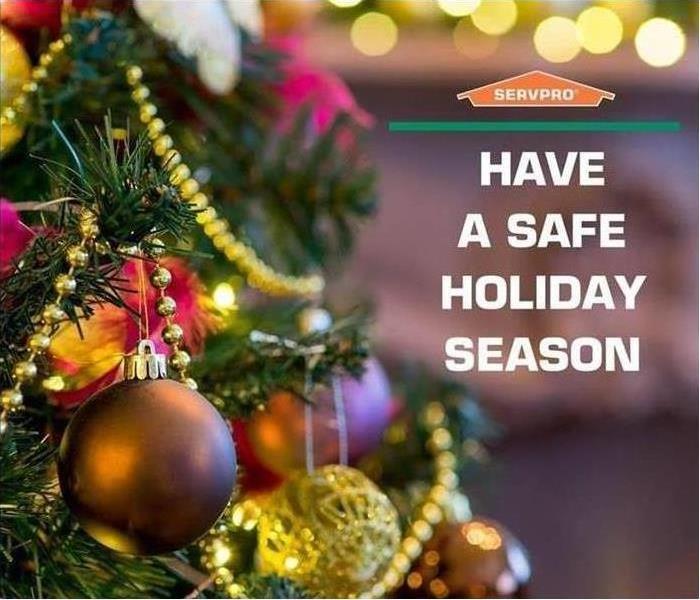 Cooking Fires
Cooking Fires
Each December, families gather to celebrate the holidays by preparing a delicious feast, but if you don’t practice safe cooking habits, your happy holiday could become hazardous very quickly. According to the National Fire Protection Association, cooking is the main cause for home fires and injuries, with Thanksgiving and Christmas being the peak days for cooking-related fires. Review the following safety tips to help ensure you enjoy a safe holiday.
- Do not wear loose clothing or dangling sleeves while cooking.
- Never leave cooking food unattended- stay in the kitchen when frying, grilling or broiling food. If someone must leave the kitchen for even a short period of time, they should turn off the stove.
- Check food regularly while cooking and remain in the home while cooking. Use a timer as a reminder that the stove or oven is on.
- Keep the kids away from the cooking area. Enforce a “kid-free zone” and make them stay at least three feet away from the stove.
- Keep anything flammable- pot holders, oven mitts, wooden utensils, paper or plastic bags, food packaging, and towels or curtains- away from the stove, oven or any other appliance in the kitchen that generates heat.
- Clean cooking surfaces on a regular basis to prevent grease buildup.
- Purchase a fire extinguisher to keep in the kitchen. Contact the local fire department to take training on the proper use of extinguishers.
- Always check the kitchen before going to bed or leaving the home to make sure all stoves, ovens, and small appliances are turned off.
- Install a smoke alarm near the kitchen, on each level of the home, near sleeping areas, and inside and outside bedrooms. Use the test button to check it each month. Replace all batteries at least once a year.
We hope you have a wonderful holiday season! SERVPRO of Friendswood/Pearland, Stafford, Missouri City North and Fresno is here to help, even on holidays if a fire or water damage tries to ruin your holiday season, and is a phone call away at (281) 412-6211.
Happy Independence Day From SERVPRO!
7/4/2019 (Permalink)
Happy 4th of July! We know summer is filled with backyard barbecues, parades, and fireworks displays, but did you know that more fires are reported on the 4th of July than any other day of the year?
Each year, fireworks cause on average 1,300 structure fires, 300 vehicle fires and nearly 17,000 other fires, including grass fires, explosions, and even people have been engulfed in flames during a seemingly innocent childhood tradition.
Before preparing your personal fireworks display, check which fireworks are legal in your area and that there is no burn-ban in affect.
Below is a list of fireworks that may be legal for purchase in your area:
- Sparklers
- Bottle Rockets
- Firecrackers (Fireworks designed to explode on the ground.)
- Roman Candles
Fireworks Safety Tips
SERVPRO is on call 24/7 for emergency fire damages, but of course, we would rather you avoid the fire hazard all together for your safety and those around you! Check out what the pro’s have to say about using fireworks safely:
- NEVER use fireworks while under the influence of drugs or alcohol.
- Do not allow young children to handle fireworks. Have an adult supervise them closely and light the fireworks for them.
- NEVER light fireworks indoors, not even sparklers! People often do not realize that common sparklers burn around 2,000 degrees - hot enough to melt some metals.
- Do not try to re-light or handle fireworks that did not ignite properly. It may seem like a “dud”, but the malfunction could cause an explosion you are not prepared for.
- Keep a bucket of water nearby to fully extinguish fireworks that have malfunctioned or have been used before discarding them in a trashcan.
- When lighting a firework, do not place your head or body over the projectile.
Suffer a Fire Damage?
SERVPRO offers 24 hours service for any emergency. Give a member of our friendly office staff a call and schedule a time for an initial inspection. In the mean time, check out our online guide on what you should do until help arrives!
For more information on SERVPRO Fire Damage Repair and Restoration services, click here.
Have a happy and safe 4th of July from SERVPRO of Friendswood/Pearland, Stafford, Missouri City North and Fresno!
To speak with a job coordinator about making an appointment, call the office at 281-412-6211.
Or visit our website: www.SERVPROfriendswoodpearland.com
Get ALARMED About Fire Safety
6/30/2019 (Permalink)
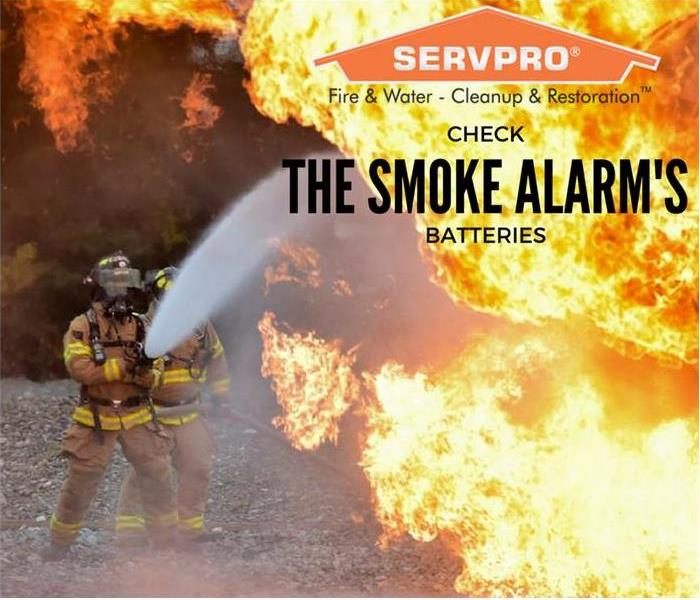 Something as simple as checking your smoke detector's batteries can help save you or the life of a loved one in the case of a fire.
Something as simple as checking your smoke detector's batteries can help save you or the life of a loved one in the case of a fire.
You probably know what the smoke alarm in your home looks like. You should also (hopefully) know where it’s located. The big question you should ask yourself is, “Does it work?”. The Residential Fire Safety Institute shows that over 92% of dwellings in the US have smoke alarms. Which sounds like a great statistic, right? But it’s also estimate that one third of those smoke alarms do not work.
Smoke Alarm Maintenance
Smoke alarms are fairly low maintenance, however, they cannot simply be installed and forgotten. Here are some tips to keep your smoke alarm functioning properly:
- Replace smoke alarms every decade. After 10 years, smoke alarms have a 30% failure rate.
- Vacuum alarms once every 6 months to once a year. An alarm clogged with dust and debris can affect the alarms’ ability to function properly.
- Install both ionization and photoelectric alarms. The ionization detectors activate quicker for flare ups or flaming fires, while photoelectric detectors work better for slow, smoldering fires.
- Test your fire alarms once every 3 months.
Where Should Smoke Alarms Be Located?
Most homes have at least one smoke detector located in a common area of the dwelling, while business have many alarms spread throughout the building. Companies cover all areas of the business, especially when a surplus of electricity or a kitchen is used.
While most businesses have all aspects covered, does your home have the same protection? While the kitchen would normally be seen as the most common area a fire would spark, fires can start in many ways and if you don’t have multiple detectors throughout your home, you risk not being notified of the fire in time for a quick, safe escape.
To ensure you’ll be alarmed no matter where you or the fire are in the home, check out this list of areas you should consider placing a smoke alarm:
- Outside each bedroom area. This could be a hallway, or game room that contains the entrances to the bedrooms.
- In each bedroom. This ensures the occupant will be alerted if a fire were to start inside the room or outside of an entrance, such as a window or door.
- If your home is multi-level, place an alarm on each level of your home, including any basement or attic areas.
- Near the kitchen and utility room. These rooms commonly hold the most appliances and contain the greatest risk for a fire hazard. Try not to keep the smoke alarm too close to the kitchen to avoid the alarm going off each time you cook.
If your home or business has suffered from fire or smoke damage, click here to check out fire/smoke restoration services. Call a member of our helpful office staff at (281) 412-6211 for more information on our services or to schedule a consultation.
The Spark of Electrical Fires
6/25/2019 (Permalink)
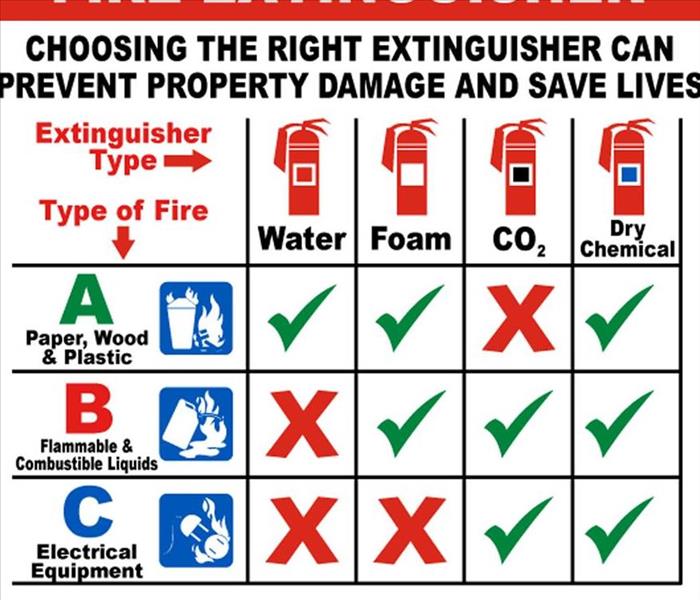 The type of fire extinguisher you use matters! Always be aware of the kind fire extinguishers you have available and where they are located.
The type of fire extinguisher you use matters! Always be aware of the kind fire extinguishers you have available and where they are located.
Fires in the home can come in many forms. One of the most dangerous fires is an electrical fire. Electrical fires are especially dangerous because not only is a fire ignited, the electricity has the potential to shock an unsuspecting victim.
Causes of Electrical Fires
Electrical fires often catch homeowners off guard when they are doing something they do everyday, like using a household appliance or plugging something into a socket or power strip. Below is a list of the common causes for electrical fires:
- Faulty outlets and appliances
- Light fixtures, lamps, and light bulbs
- Extension cords
- Space heaters
- Faulty wiring
December and January are the months with the most electrical fires due to an increased amount of heating appliances and lights. However, electrical fires can spark without the overhaul of Christmas lights. Overburdening your electrical outlets with any appliances can quickly spark an electrical fire.
How to Prevent an Electrical Fire
Here are some helpful tips to keep from falling victim to an electrical fire:
- Discard all cords and plugs that are worn or frayed
- Never break off the 3rd prong on a plug to plug it in to a 2-prong socket.
- Keep electrical cords away from water and heat sources.
- Avoid running electrical cords under rugs.
- When unplugging an item, hold the plug securely and remove the plug from the outlet.
- Only use extension cords temporarily
Properly Putting Out an Electrical Fire
Because electricity is involved, you cannot put out an electrical fire the same way you would a typical fire.
- Call 911 and GET OUT
- Call your local fire department or dial 911.
- Safely exit the building.
- Keep a safe distance from the building until fire fighters arrive.
- Disconnect the Electricity
- If an appliance is on fire, simply unplug the appliance by grabbing the plug and disconnecting from the wall.
- If the fire is in the wall or in an appliance you can’t unplug, safely get to the switch or electrical panel to shut off the electricity.
If the power is ON:
- Smother a small fire with baking soda.
- Use only a class C or ABC fire extinguisher. Remember to use the fire extinguisher properly.
- NEVER use water on an electrical fire that is still energized.
If the power is OFF:
- Use a fire extinguisher. If the power is off, it doesn’t matter which kind of fire extinguisher.
- Use a fire blanket or other thick blanket to smother the fire.
- Douse the fire with water. This is only safe and effective if the power source is OFF.
If your home or business has suffered an electrical fire, call SERVPRO of Friendswood/Pearland, Stafford, Missouri City North and Fresno to speak to an expert about cleaning your home and saving your personal belongings!
Ask us about odor removal and how to care for other belongings affected by fires.
For more information on the SERVPRO's fire restoration process, click here.
Phone: 281-412-6211
Website: www.SERVPROfriendswoodpearland.com
Repair Fire Damage Quickly!
2/8/2019 (Permalink)
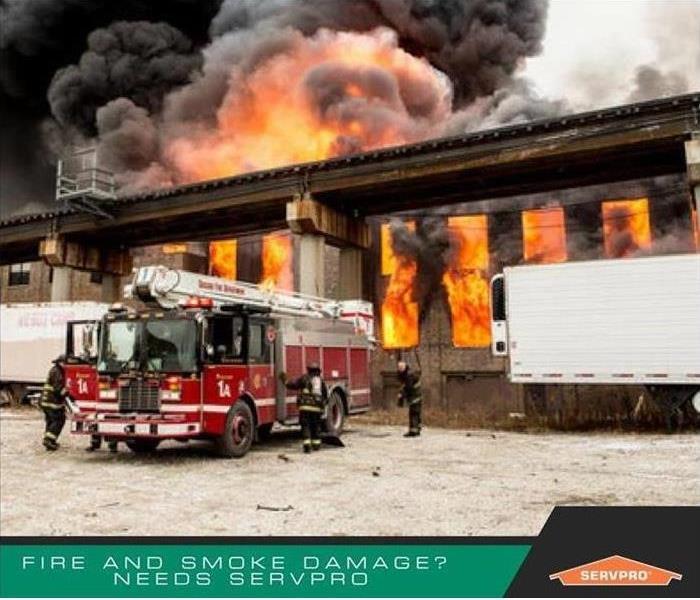 Mitigation Over Replacing
Mitigation Over Replacing
Fire damage and a fire loss can be repaired by a fire cleanup crew in a few short days and it is faster to contact the commercial fire damage company when the fire is still raging (After you have called Emergency Services first). Our fire damage repair crew will arrive on the scene and immediately begin the process of repairing the home. There are fire problems you may not expect to be as severe as they actually are as well as other issues most homeowners don't even consider that have nothing to do with the actual fire. For example, if the Fire Department came to your house and had to use a hose to douse the flames you will have some amount of water damage.
Remember: Mitigation Over Replacing
- Cost Effective. It is by far cheaper and easier to clean an item than it is to replace it. The Faster SERVPRO can respond to your damage the higher the chance we can save some of your personal items.
- Preserve Air Quality. The longer ash and soot lingers in the air the more it becomes hazardous to your health.
- Keep The Smell Out. If SERVPRO can get to the scene soon after the damage occurs it is possible to prevent the permanent smell of burning from seeping into clothes and furniture.
- Prevent Mold. If water was poured onto the fire it stands to reason it soaked your floors and appliances. Left untreated it becomes a perfect breeding ground for mold.
- Save Time. Believe it or not, the longer damage sits it becomes worse, even if you think its as bad as its going to get. The worse a job is the longer it takes to clean up. Still, it is always faster to repair than it is to build anew.
- Peace of Mind. The faster your life gets back to normal the less amount of stress is put on your body and mind. Fewer days laying awake at night in a place that isn't your own. Less stress equals a healthier and happier life. You can also rest assured the job was/is being done properly so there are no issues down the line because of cutting corners.
When you have fire damage it feels like your life is going up in flames. Breath (just not in the smoke). SERVPRO of Friendswood/Pearland will come to the rescue and do what we do best. Make it "Like it never even happened." or better!
Can You Inspect a Fire Extinguisher?
2/8/2019 (Permalink)
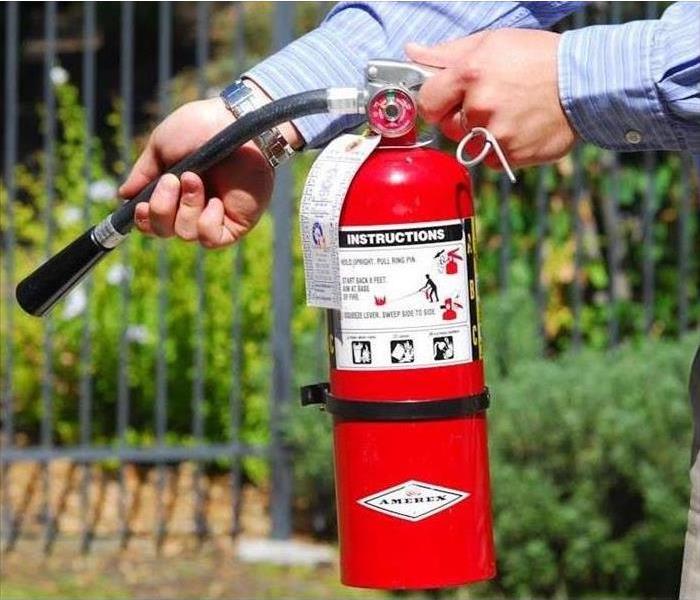 In the event of a fire emergency, first make sure to get people safely away, then call 911.
In the event of a fire emergency, first make sure to get people safely away, then call 911.
When was the last time you took the time to check the fire extinguisher that sits under your kitchen sink? Or the one hanging from a rusty hook in your garage? If you’re struggling to remember, it’s time to check it. Like any other piece of safety equipment, a home fire extinguisher should be inspected regularly to ensure it’s in proper working condition. A fire extinguisher in good working condition is your first line of defense when a home fire erupts.
Ideally, you should inspect your portable home fire extinguishers every month.
For the visual guide click here.
Tips for Performing a Monthly Fire Extinguisher Check
Check the label or tag.
Every fire extinguisher, whether disposable or rechargeable, has a manufacturer’s label or tag. Read the tag and follow the manufacturer’s recommended maintenance suggestions.
Check the tamper seal.
If the tamper seal has been broken or is cracked, a disposable fire extinguisher needs to be replaced. If it’s rechargeable, it needs to be serviced professionally. Check the locking or pull pin as well to make sure it’s in the correct position. If the pin missing, the fire extinguisher needs to be inspected or serviced by a professional.
Inspect for physical damage.
Physically inspect the fire extinguisher for obvious damage. This may include but is not limited to dents, corrosion, cracks and obvious leakage. If a fire extinguisher has leakage, it’s no longer under full pressure and may not work properly when you need it most. Check the fire extinguisher nozzle as well, to ensure it’s not clogged by grime, dust, bugs or leakage from the unit itself.
Check the pressure gauge.
Check that the pressure gauge needle indicates the fire extinguisher pressure is in the optimum operating range. Often the correct pressure range will be designated by green on the gauge.
Is the fire extinguisher full?
During your monthly check, lift the fire extinguisher and determine if it still feels full. If there has been a leak, it will feel light, and it won’t have the right amount of pressure to work correctly.
Shake it.
If you have a dry chemical fire extinguisher, it should be shaken once a month during your inspection. This helps prevent the chemical dousing agent from solidifying at the bottom of the unit.
Write the inspection date on the tag.
Keep track of every inspection date by writing it on the fire extinguisher tag.
Ensure easy access to your fire extinguisher.
Fire extinguishers should always be easy to access if there is an emergency. You don’t want to have to search for it once a fire breaks out. Don’t block fire extinguishers with furniture, boxes or any other items. Everyone who lives in the household should know where the closest fire extinguisher is located and how to use it in case of an emergency.
In the event of a fire emergency, first make sure to get people safely away, then call 911. A home fire extinguisher can be used to put out or control small fires, but it’s still safest to call professional firefighters before you attempt to control a fire on your own. If you need professional fire, smoke and water damage cleanup, and remediation after a fire, call the experts at SERVPRO of Friendswood/Pearland. 281-412-6211
Don't Overload Your Room's Electrical Outlets
1/29/2019 (Permalink)
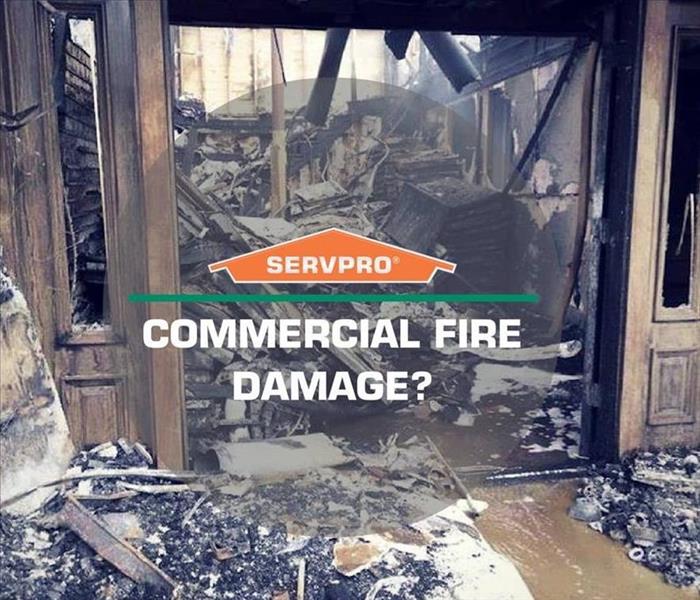 Don't use too many multi-plug devices.
Don't use too many multi-plug devices.
Most electrical outlets are designed to handle a specific amperage. It’s best not to try to push them to their capacity by using too many multi-plug devices. If you ever notice any scorched marks or burning odors around an electrical outlet, stop using that outlet and inform someone of the problem right away.
Overloaded circuit warning signs:
- Flickering, blinking, or dimming lights
- Frequently tripped circuit breakers or blown fuses
- Warm or discolored wall plates
- Cracking, sizzling, or buzzing from receptacles
- Burning order coming from receptacles or wall switches
- Mild shock or tingle from appliances, receptacles, or switches
How to prevent electrical overloads:
- Never use extension cords or multi-outlet converters for appliances
- All major appliances should be plugged directly into a wall receptacle outlet. Only plug one heat-producing appliance into a receptacle outlet at a time
- A heavy reliance on extension cords is an indication that you have too few outlets to address your needs. Have a qualified electrician inspect your home and add new outlets
- Power strips only add additional outlets; they do not change the amount of power being received from the outlet
Have Questions? Call Us Today –
(281) 412-6211
Smoke Alarms
12/28/2018 (Permalink)
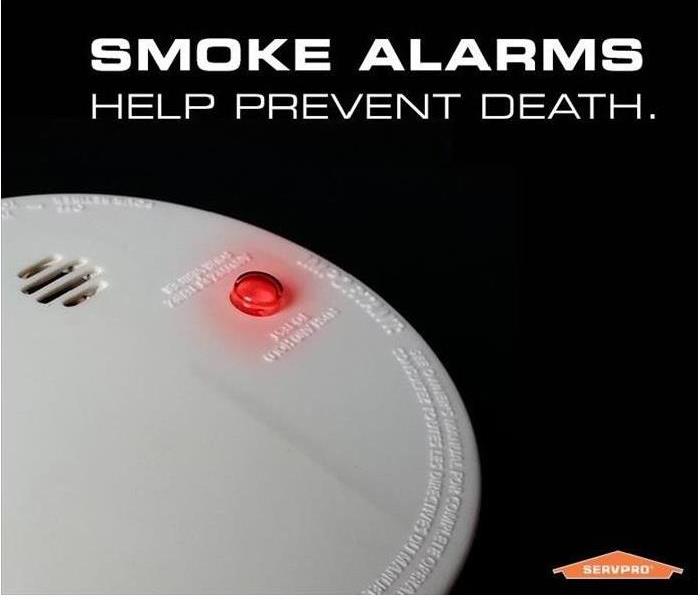 Smoke alarms save lives.
Smoke alarms save lives.
There are two kinds of alarms. Ionization smoke alarms are quicker to warn about flaming fires. Photoelectric alarms are quicker to warn about smoldering fires. It is best to use both types of alarms in the home.
Install smoke alarms inside and outside each bedroom and sleeping area and make sure everyone in the home knows what to do if the alarm sounds.
Install alarms on every level of the home. Large homes may need extra smoke alarms.
It is best to use interconnected smoke alarms when one smoke alarm sounds they all sound.
A smoke alarm should be on the ceiling or high on a wall. Keep smoke alarms away from the kitchen to reduce false alarms. They should be at least 10 feet from the stove.
People who are hard-of-hearing or deaf can use special alarms equipped with strobe lights and bed shakers.
Replace all smoke alarms every 10 years, and test the batteries once a month.
SERVPRO of Friendswood/Pearland knows the ins and outs of fire safety, but sometimes even the most safety-conscience can face tragedy. If you've had fire damage in your home, large or small, call 281-412-6211 for 24-hour service.
Holiday Mishaps
12/28/2018 (Permalink)
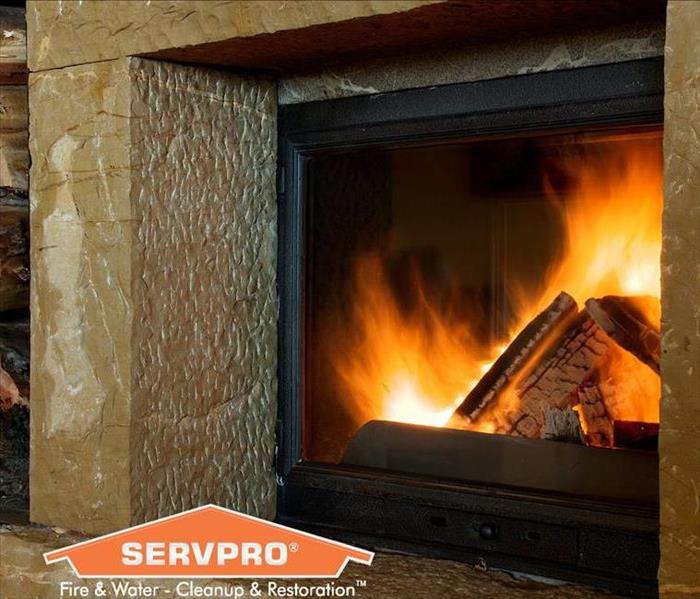 Test smoke alarms monthly and replace after 10 years.
Test smoke alarms monthly and replace after 10 years.
The winter season is fast approaching! The days are getting shorter and the temperatures are getting lower here in Southeast Texas. It’s almost time to start breaking out the portable space heaters and firing up those fireplaces and wood burning stoves.
Did you know?
According to the National Fire Protection Association, heating equipment is responsible for an estimated $893 million in property damage annually? Heating is the second leading cause of residential-fire deaths. Those of us here at SERVPRO of Friendswood/Pearland, in conjunction with the NFPA have put together a few tips to reduce the risk of a heating-related fire and to keep your homes and families safe this winter.
- Keep anything flammable at least three feet from heating equipment, like the furnace, fireplace, wood stove, or a portable space heater. Have a three-foot “kid & pet-free zone” around open fires and space heaters.
- Remember to turn portable heaters off when leaving the room or going to bed.
- Always use the right kind of fuel, specified by the manufacturer, for fuel-burning space heaters.
- Make sure the fireplace has a sturdy screen to stop sparks from flying into the room. Ashes should be cool before putting them in a metal container for disposal. Keep the container a safe distance away from your home.
- Have heating equipment and chimneys cleaned and inspected every year by a qualified professional.
- Have a qualified professional install stationary space heating equipment, water heaters or central heating equipment according to the local codes and manufacturer’s instructions.
- Test smoke alarms monthly and replace after 10 years.
If you or someone you know has fire damage in your home, large or small, call Kimberly at 281-520-8197 for 24-hour service. SERVPRO of Friendswood/Pearland is at your service.
Don't Overload Your Room's Electrical Outlets
12/26/2018 (Permalink)
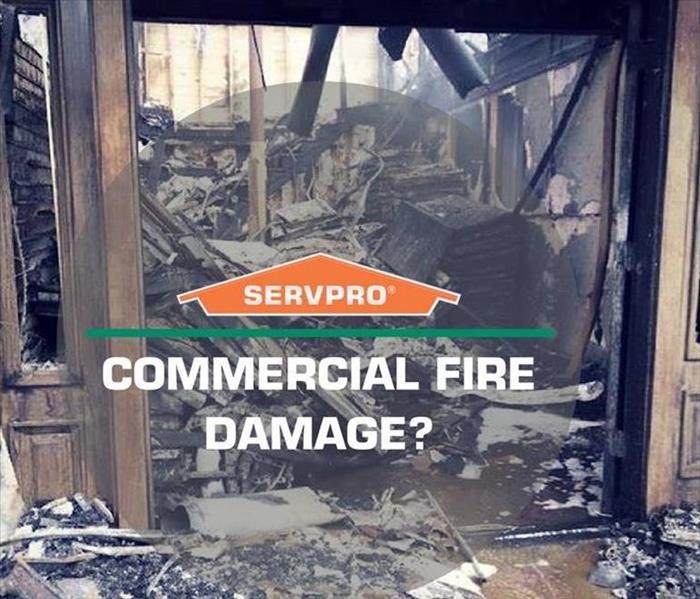 Don't use too many multi-plug devices.
Don't use too many multi-plug devices.
Most electrical outlets are designed to handle a specific amperage. It’s best not to try to push them to their capacity by using too many multi-plug devices. If you ever notice any scorched marks or burning odors around an electrical outlet, stop using that outlet and inform someone of the problem right away.
Overloaded circuit warning signs:
- Flickering, blinking, or dimming lights
- Frequently tripped circuit breakers or blown fuses
- Warm or discolored wall plates
- Cracking, sizzling, or buzzing from receptacles
- Burning order coming from receptacles or wall switches
- Mild shock or tingle from appliances, receptacles, or switches
How to prevent electrical overloads:
- Never use extension cords or multi-outlet converters for appliances
- All major appliances should be plugged directly into a wall receptacle outlet. Only plug one heat-producing appliance into a receptacle outlet at a time
- A heavy reliance on extension cords is an indication that you have too few outlets to address your needs. Have a qualified electrician inspect your home and add new outlets
- Power strips only add additional outlets; they do not change the amount of power being received from the outlet
Have Questions? Call Us Today –
SMOKE ALARMS SAVE LIVES: HERE’S WHAT YOU SHOULD KNOW
10/19/2018 (Permalink)
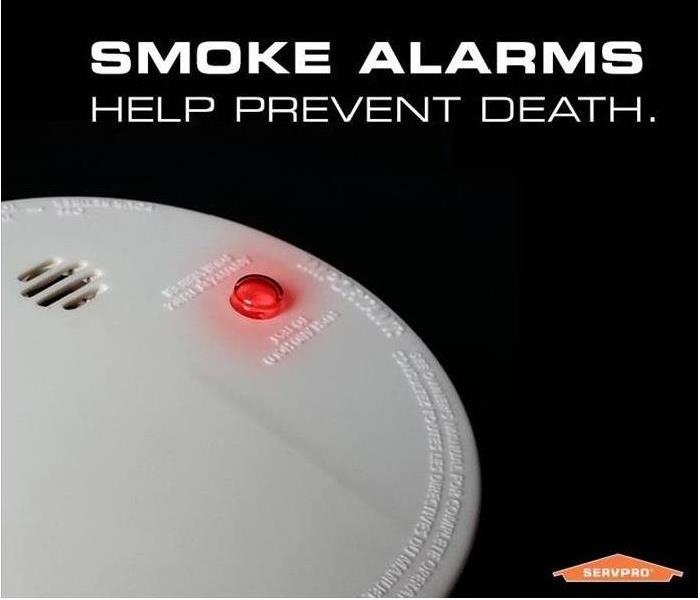 Smoke alarms are a key part of a home fire escape plan.
Smoke alarms are a key part of a home fire escape plan.
There are two kinds of alarms. Ionization smoke alarms are quicker to warn about flaming fires. Photoelectric alarms are quicker to warn about smoldering fires. It is best to use both types of alarms in the home.
Install smoke alarms inside and outside each bedroom and sleeping area and make sure everyone in the home knows what to do if the alarm sounds.
Install alarms on every level of the home. Large homes may need extra smoke alarms.
It is best to use interconnected smoke alarms when one smoke alarm sounds they all sound.
A smoke alarm should be on the ceiling or high on a wall. Keep smoke alarms away from the kitchen to reduce false alarms. They should be at least 10 feet from the stove.
People who are hard-of-hearing or deaf can use special alarms equipped with strobe lights and bed shakers.
Replace all smoke alarms every 10 years, and test the batteries once a month.
SERVPRO of Friendswood/Pearland knows the ins and outs of fire safety, but sometimes even the most safety-conscience can face tragedy. If you've had a fire damage in your home, large or small, call Kimberly at 281-520-8197 for 24-hour service.
Electrical Fires
10/18/2018 (Permalink)
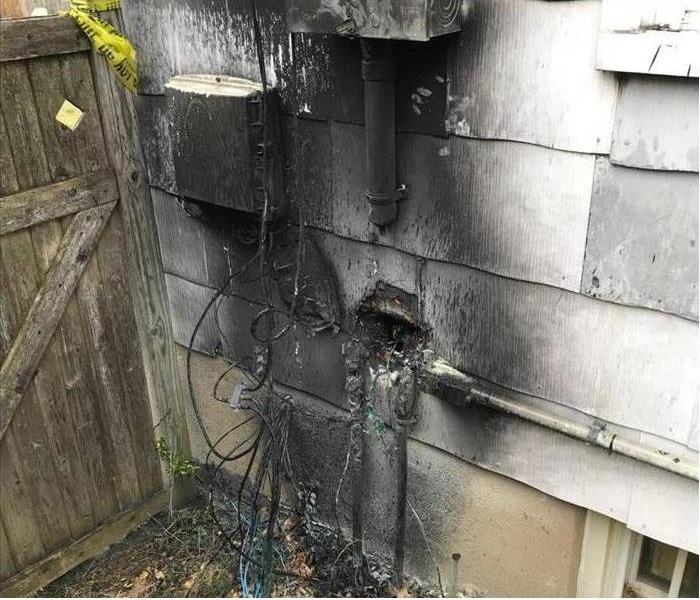 Some electrical fires happen because of problems in house wiring or appliance failure.
Some electrical fires happen because of problems in house wiring or appliance failure.
When an electrical fire happens most people are taken by surprise. It usually happens from a simple act done a hundred times before such as turning on a light switch or plugging in your phone, but this time it causes sparks to fly. There are few tells to look for indicating a fire is imminent. Yet with today's safety standards in modern-day products, electrical fires happen so rarely even when we push the wiring to its limit that we are lured into a false sense of security.
Remember To Look For:
Frayed Wiring- There is always that one cell phone charger that seems to pull at the ends and become frayed. The wiring may be exposed but you continue to use it anyway because it still works. Please don't. The exposed wiring could spark at any time and cause a fire that would be much more expensive to pay for over buying a new charger.
Old Wiring- In between the walls of every home runs a maze of circuitry and copper wiring. All homes are built to code with plenty of electrical charges to sustain modern appliances. As time goes on and we invent bigger, better, and more energy consuming products it becomes harder for the old wiring to keep up.
Overpopulated Extension Cords- During the holiday season, this becomes the most common fire hazard. It is also the most common cause of fires during the month of December.
High Wattage Bulbs- Every lamp comes with a little warning label informing the owner of the highest wattage it can safely use. Do not stick any bulb in a light fixture because it fits.
Space Heaters- The most common cause of a household fire occurring because of these is due to the nature of how easy it is to light fabrics on fire. Keep space heaters away from curtains and organic products.
Electrical Fires
2/19/2018 (Permalink)
When an electrical fire happens most people are taken by surprise. It usually happens from a simple act done a hundred times before such as turning on a light switch or plugging in your phone, but this time it causes sparks to fly. There are few tells to look for indicating a fire is eminent. Yet with today's safety standards in modern day products, electrical fires happen so rarely even when we push the wiring to its limit that we are lured into a false sense of security.
Remember To Look For:
Frayed Wiring- There is always that one cellphone charger that seems to pull at the ends and become frayed. The wiring may be exposed but you continue to use it anyways because it still works. Please don't. The exposed wiring could spark at anytime and cause a fire that would be much more expensive to pay for over buying a new charger.
Old Wiring- In between the walls of every home runs a maze of circuitry and copper wiring. All homes are built to code with plenty of electrical charge to sustain modern appliances. As time goes on and we invent bigger, better, and more energy consuming products it becomes harder for the old wiring to keep up.
Overpopulated Extension Cords- During the holiday season this becomes the most common fire hazard. It is also the most common cause of fires during the month of December.
High Wattage Bulbs- Every lamp comes with a little warning label informing the owner of the highest wattage it can safely use. Do not stick any bulb in a light fixture because it fits.
Space Heaters- The most common cause of a household fire occurring because of these is due to the nature of how easily it is to light fabrics on fire. Keep space heaters away from curtains and organic products.
Why Repair Fire Damage So Quickly?
2/8/2018 (Permalink)
Fire damage and a fire loss can be repaired by a fire cleanup crew in a few short days and it is faster to contact the commercial fire damage company when the fire is still raging (After you have called Emergency Services first). Our fire damage repair crew will arrive on scene and immediately begin the process of repairing the home. There are fire problems you may not expect to be as severe as they actually are as well as other issues most homeowners don't even consider that have nothing to do with the actual fire. For example, if the Fire Department came to your house and had to use a hose to douse the flames you will have some amount of water damage.
Remember: Mitigation Over Replacing
- Cost Effective. It is by far cheaper and easier to clean an item than it is to replace it. The Faster SERVPRO can respond to your damage the higher the chance we can save some of your personal items.
- Preserve Air Quality. The longer ash and soot lingers in the air the more it becomes hazardous to your health.
- Keep The Smell Out. If SERVPRO can get to the scene soon after the damage occurs it is possible to prevent the permanent smell of burning from seeping into clothes and furniture.
- Prevent Mold. If water was poured onto the fire it stands to reason it soaked your floors and appliances. Left untreated it becomes a perfect breeding ground for mold.
- Save Time. Believe it or not the longer a damage sits it becomes worse, even if you think its as bad as its going to get. The worse a job is the longer it takes to clean up. Still, it is always faster to repair than it is to build anew.
- Peace of Mind. The faster your life gets back to normal the less amount of stress is put on your body and mind. Fewer days laying awake at night in a place that isn't your own. Less stress equals a healthier and happier life. You can also rest assured the job was/is being done properly so there are no issues down the line because of cutting corners.
When you have a fire damage it feels like your life is going up in flames. Breath (just not in the smoke). SERVPRO of Friendswood/Pearland, Stafford, Missouri City North and Fresno will come to the rescue and do what we do best. Make it "Like it never even happened." or better! Give Kimberly a call at 281-520-8197 or Madeline 281-520-8196
How To Inspect A Fire Extinguisher
2/8/2018 (Permalink)
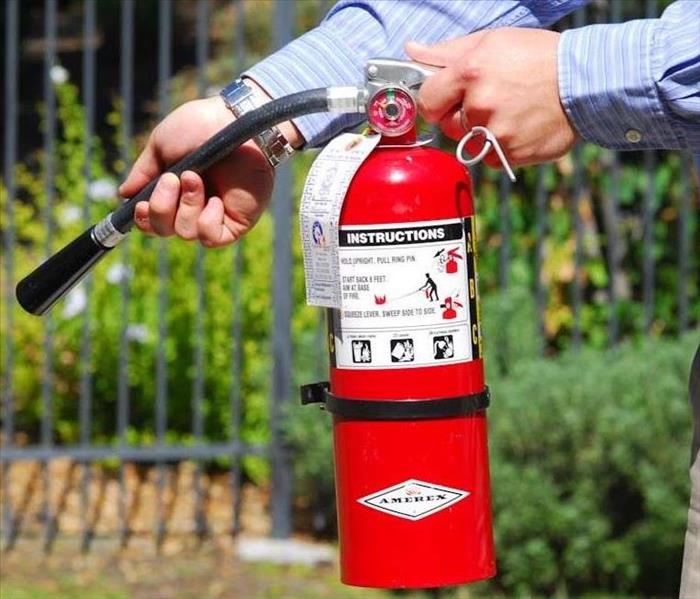 Pro Tip: You can purchase a small fire extinguisher for around $30
Pro Tip: You can purchase a small fire extinguisher for around $30
When was the last time you took time to check the fire extinguisher that sits under your kitchen sink? Or the one hanging from a dusty hook in your garage? If you’re struggling to remember, it’s time to check it. Like any other piece of safety equipment, a home fire extinguisher should be inspected regularly to ensure it’s in proper working condition. A fire extinguisher in good working condition is your first line of defense when a home fire erupts.
Ideally, you should inspect your portable home fire extinguishers every month.
For the visual guide click here.
Tips for Performing a Monthly Fire Extinguisher Check
Check the label or tag.
Every fire extinguisher, whether disposable or rechargeable, has a manufacturer’s label or tag. Read the tag and follow the manufacturer’s recommended maintenance suggestions.
Check the tamper seal.
If the tamper seal has been broken or is cracked, a disposable fire extinguisher needs to be replaced. If it’s rechargeable, it needs to be serviced professionally. Check the locking or pull pin as well to make sure it’s in the correct position. If the pin missing, the fire extinguisher needs to be inspected or serviced by a professional.
Inspect for physical damage.
Physically inspect the fire extinguisher for obvious damage. This may include but is not limited to dents, corrosion, cracks and obvious leakage. If a fire extinguisher has leakage, it’s no longer under full pressure and may not work properly when you need it most. Check the fire extinguisher nozzle as well, to ensure it’s not clogged by grime, dust, bugs or leakage from the unit itself.
Check the pressure gauge.
Check that the pressure gauge needle indicates the fire extinguisher pressure is in the optimum operating range. Often the correct pressure range will be designated by green on the gauge.
Is the fire extinguisher full?
During your monthly check, lift the fire extinguisher and determine if it still feels full. If there has been a leak, it will feel light, and it won’t have the right amount of pressure to work correctly.
Shake it.
If you have a dry chemical fire extinguisher, it should be shaken once a month during your inspection. This helps prevent the chemical dousing agent from solidifying at the bottom of the unit.
Write inspection date on tag.
Keep track of every inspection date by writing it on the fire extinguisher tag.
Ensure easy access to your fire extinguisher.
Fire extinguishers should always be easy to access if there is an emergency. You don’t want to have to search for it once a fire breaks out. Don’t block fire extinguishers with furniture, boxes or any other items. Everyone who lives in the household should know where the closest fire extinguisher is located and how to use it in case of an emergency.
In the event of a fire emergency, first make sure to get people safely away, then call 911. A home fire extinguisher can be used to put out or control small fires, but it’s still safest to call professional fire fighters before you attempt to control a fire on your own. If you need professional fire, smoke and water damage cleanup and remediation after a fire, call the experts at SERVPRO of Friendswood/Pearland, Stafford, Missouri City North and Fresno. Kimberly 281-520-8197 or Madeline 281-520-8196
Grill Safety
1/30/2018 (Permalink)
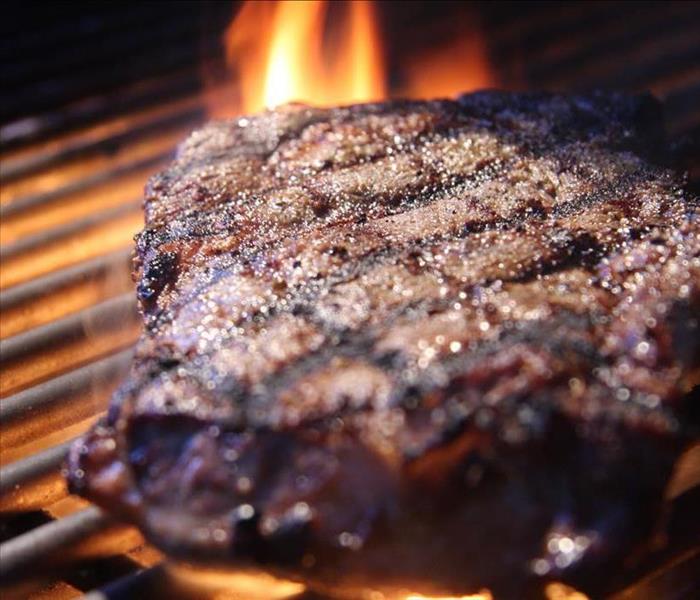 Did you know you can tell the tenderness of a steak by comparing it to the firmness of your palm when you touch your thumb to any other finger?
Did you know you can tell the tenderness of a steak by comparing it to the firmness of your palm when you touch your thumb to any other finger?
The smell of BBQ in the air is a Texas trademark that happens near year-round. During the summer there is nothing better than going outside on a nice day with friends and family to grill burgers or in the fall roasting marshmallows over Dad's old foreman. This all providing you do it safely. To make sure you don't burn the steaks, here is a quick guide so you can continue the Texas tradition of making outdoor cuisine.
The Do’s and Don’ts of grill safety:
Do:
- Keep your grill at least ten feet away from your house
- Make sure to keep your grill clean
- Always check for gas leaks
- Make sure to keep decorations or anything that may be flammable up away from your grill
- In the case of flare-ups, it is good to keep a spray bottle of water near your grill
- Always keep a fire hydrant handy
Don't:
- Never turn your gas on when the lid is shut
- Do not leave your grill unattended
- Never use your grill inside your home
- Do not Grill underneath a tree
- Be cautious to not wear loose clothing when grilling as it could catch on fire. A 'Kiss the Cook' apron is ideal.
Tip: If you are using a propane tank and there is a leak, once you turn the tank on you will be able to see bubbles forming around the hose.
What To Do In Case Of Fire
1/30/2018 (Permalink)
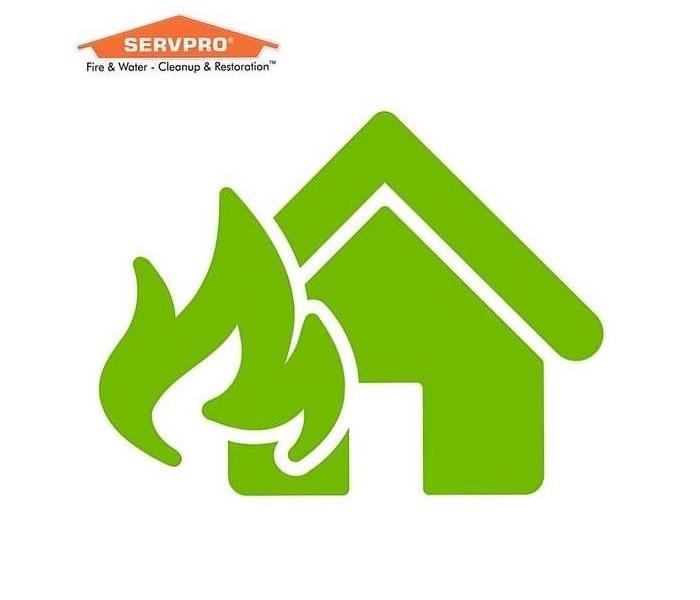 Learn what you and your family should do if a fire starts in your home.
Learn what you and your family should do if a fire starts in your home.
In The Same Room As A Fire
**Please do not stay in the same room as the fire if you do not feel comfortable or confident in your ability to control it. Evacuate Immediately and call 911 to alert the professionals**
Kitchen-
- Grease: Turn off the burner. Grab a non-glass lid or baking sheet for the pot/pan and place over the fire while wearing oven mitts.
- Oven: Smother the fire by throwing baking soda or salt onto it. Do NOT use similar products such as flour. It could cause an explosion.
General Room-
- Electrical: If you can reach the cord safely, unplug it. Using a heavy blanket or baking soda, you can smolder the fire if it is small. Do NOT use water as it may worsen or cause a shock.
- General: Use a Fire Extinguisher if you have one available. For a guide on how to use an extinguisher please see our SERVPRO video. ( https://www.youtube.com/watch?v=gFifToYGgto&feature=youtu.be )
Don’t Overload Your Room’s Electrical Outlets.
12/14/2017 (Permalink)
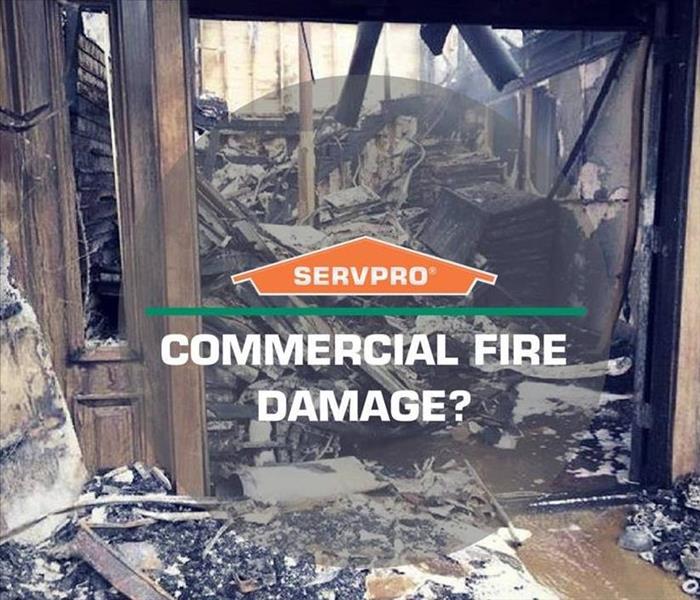 Don't use too many multi-plug devices.
Don't use too many multi-plug devices.
Overloaded circuit warning signs:
- Flickering, blinking, or dimming lights
- Frequently tripped circuit breakers or blown fuses
- Warm or discolored wall plates
- Cracking, sizzling, or buzzing from receptacles
- Burning order coming from receptacles or wall switches
- Mild shock or tingle from appliances, receptacles, or switches
How to prevent electrical overloads:
- Never use extension cords or multi-outlet converters for appliances
- All major appliances should be plugged directly into a wall receptacle outlet. Only plug one heat-producing appliance into a receptacle outlet at a time
- A heavy reliance on extension cords is an indication that you have too few outlets to address your needs. Have a qualified electrician inspect your home and add new outlets
- Power strips only add additional outlets; they do not change the amount of power being received from the outlet
Have Questions? Call Us Today – (281) 412-6211
AVOID HOLIDAY MISHAPS
10/13/2016 (Permalink)
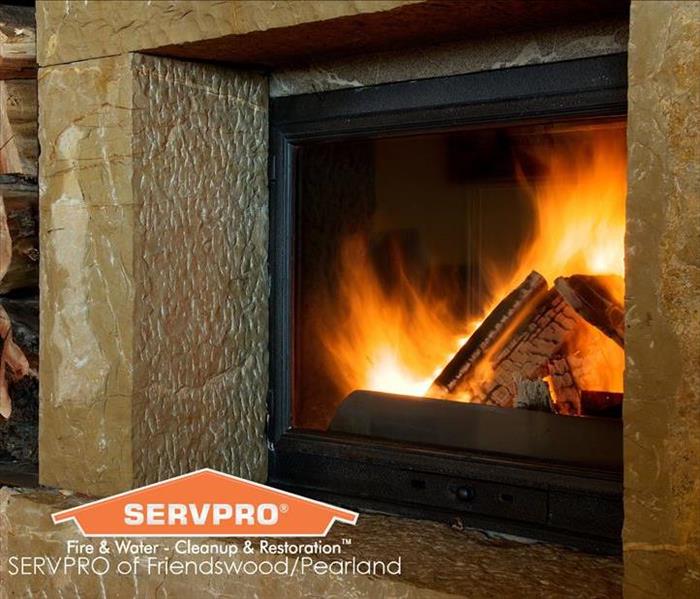 Wood-burning fireplace keeps you nice and cozy!
Wood-burning fireplace keeps you nice and cozy!
The winter season is fast approaching! The days are getting shorter and the temperatures are getting lower here in Southeast Texas. It’s almost time to start breaking out the portable space heaters and firing up those fireplaces and wood burning stoves.
Did you know?
According to the National Fire Protection Association, heating equipment is responsible for an estimated $893 million in property damage annually? Heating is the second leading cause of residential-fire deaths. Those of us here at SERVPRO in conjunction with the NFPA have put together a few tips to reduce the risk of a heating-related fire and to keep your homes and families safe this winter.
- Keep anything flammable at least three feet from heating equipment, like the furnace, fireplace, wood stove, or a portable space heater. Have a three-foot “kid & pet-free zone” around open fires and space heaters.
- Remember to turn portable heaters off when leaving the room or going to bed.
- Always use the right kind of fuel, specified by the manufacturer, for fuel burning space heaters.
- Make sure the fireplace has a sturdy screen to stop sparks from flying into the room. Ashes should be cool before putting them in a metal container for disposal. Keep the container a safe distance away from your home.
- Have heating equipment and chimneys cleaned and inspected every year by a qualified professional.
- Have a qualified professional install stationary space heating equipment, water heaters or central heating equipment according to the local codes and manufacturer’s instructions.
- Test smoke alarms monthly and replace after 10 years.
If you or someone you know has fire damage in your home, large or small, call Kimberly at 281-520-8197 or Madeline 281-520-8196 for 24-hour service. SERVPRO Friendswood/Pearland, Stafford, Missouri City North and Fresno is at your service. We’ll make it “Like it never happened.”
SMOKE ALARMS SAVE LIVES: HERE’S WHAT YOU SHOULD KNOW
10/6/2016 (Permalink)
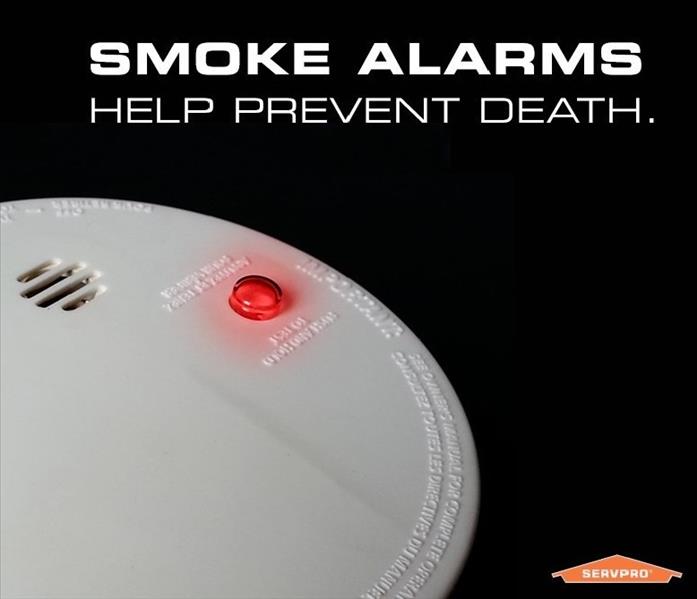 Smoke alarms are a key part of a home fire escape plan.
Smoke alarms are a key part of a home fire escape plan.
There are two kinds of alarms. Ionization smoke alarms are quicker to warn about flaming fires. Photoelectric alarms are quicker to warn about smoldering fires. It is best to use both types of alarms in the home.
Install smoke alarms inside and outside each bedroom and sleeping area and make sure everyone in the home knows what to do if the alarm sounds.
Install alarms on every level of the home. Large homes may need extra smoke alarms.
It is best to use interconnected smoke alarms, when one smoke alarm sounds they all sound.
A smoke alarm should be on the ceiling or high on a wall. Keep smoke alarms away from the kitchen to reduce false alarms. They should be at least 10 feet from the stove.
People who are hard-of-hearing or deaf can use special alarms equipped with strobe lights and bed shakers.
Replace all smoke alarms every 10 years, and test the batteries once a month.
Friendswood/Pearland, Stafford, Missouri City North and Fresno knows the ins and outs of fire safety, but sometimes even the most safety-conscience can face tragedy. If you've had a fire damage in your home, large or small, call Kimberly at 281-520-8197 or Madeline at 281-520-8196 for 24-hour service.




 24/7 Emergency Service
24/7 Emergency Service






























